Debugging
The RelationalAI (RAI) Debugger is a browser-based tool that ships with the relationalai Python package.
You can use it to identify issues with your model, such as incorrect query results, slow query performance, or unexpected behavior.
Tutorial: Use the Debugger
Section titled “Tutorial: Use the Debugger”This tutorial walks you through the steps to open the RAI debugger, connect a program to it, and interact with the debugger interface. You’ll create a model with some bugs and use the debugger to identify and fix them.
Set Up Your Environment
Section titled “Set Up Your Environment”To use the RAI Debugger, you need to have a local Python environment with the relationalai package installed:
# Create a new project folder.mkdir my_projectcd my_project
# Create a new virtual environment.# NOTE: Use the python3.9 or python3.10 command if you're using a different version of Python.python3.11 -m venv .venv
# Activate the virtual environment.source .venv/bin/activate
# Update pip and install the relationalai package.# NOTE: python -m ensures that the pip command is run for your virtual environment.python -m pip install -U pippython -m pip install relationalai# Create a new project folder.mkdir my_projectcd my_project
# Create a new virtual environment.python -m venv .venv
# Activate the virtual environment..\.venv\Scripts\activate
# Upgrade pip and install the relationalai package.# NOTE: python -m ensures that the pip command is run for your virtual environment.python -m pip install -U pippython -m pip install relationalaiStart The Debug Server
Section titled “Start The Debug Server”Run the following command in your terminal to start the RAI Debugger server:
rai debuggerA new tab opens in your default browser to display the debugger interface:
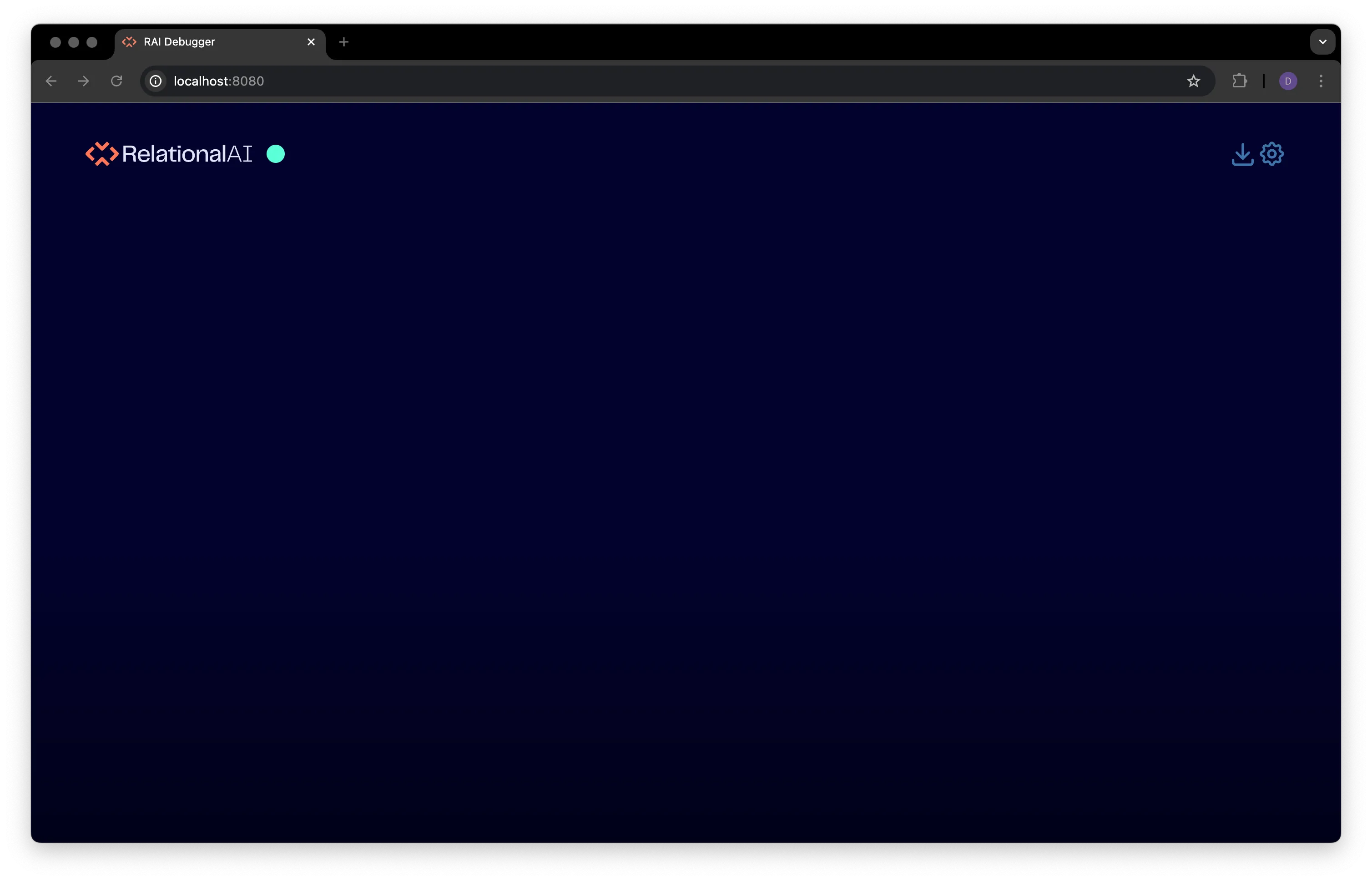
When it first opens, the debugger interface is empty.
As you execute Python applications or Jupyter notebooks that use the relationalai package, the interface updates to show the execution timeline for the program.
Programs automatically connect to the debug server over the local network, unless their configuration sets the debug configuration key to False.
Multiple programs can be viewed in the same debugger window simultaneously.
See Multiple Connections for details.
Customize The Debug Host and Port (Optional)
Section titled “Customize The Debug Host and Port (Optional)”If necessary, you can change the host name and port used by the debug server by:
-
Using the
--hostand--portoptions when running therai debuggerCLI command -
Setting the
debug.hostanddebug.portconfiguration keys in yourraiconfig.tomlfile.
rai debugger --host my_host --port 1234debug = truedebug.host = "my_host" # default is "localhost"debug.port = 1234 # default is 8080active_profile = "default"
[profile.default]user = <SNOWFLAKE_USER>password = <SNOWFLAKE_PASSWORD>account = <SNOWFLAKE_ACCOUNT_ID>role = <SNOWFLAKE_ROLE>warehouse = <SNOWFLAKE_WAREHOUSE>Using the values from the custom configuration above, you’d point your browser to <my_host>:1234 to view the debugger interface.
View a Program’s Execution Timeline in the Debugger
Section titled “View a Program’s Execution Timeline in the Debugger”Follow these steps to view a program in the debugger:
-
Create a model.
In a file named
my_project/model.py, create a file with the following code:my_project/model.py import relationalai as raifrom relationalai.std import as_rowsPERSON_DATA = [{"id": 1, "name": "Alice"},{"id": 2, "name": "Bob"},{"id": 3, "name": "Carol"},]# Create a Model object.model = rai.Model("MyModel")Person = model.Type("Person")# Add data to the types from the hardcoded data.with model.rule():data = as_rows(PERSON_DATA)Person.add(id=data.id).set(name=data.name)# Query the data.with model.query() as select:person = Person()response = select(person.id, person.name)print(response.results) -
Run the program.
In a separate terminal window, activate your project’s virtual environment and then run the
model.pyfile:Terminal window # Activate the virtual environment. On macOS/Linux, use:source venv/bin/activate# On Windows, use:.\venv\Scripts\activate# Execute the model.py file with Python.python model.py -
View the execution timeline.
In the debugger interface, you’ll see a timeline of the model’s execution:
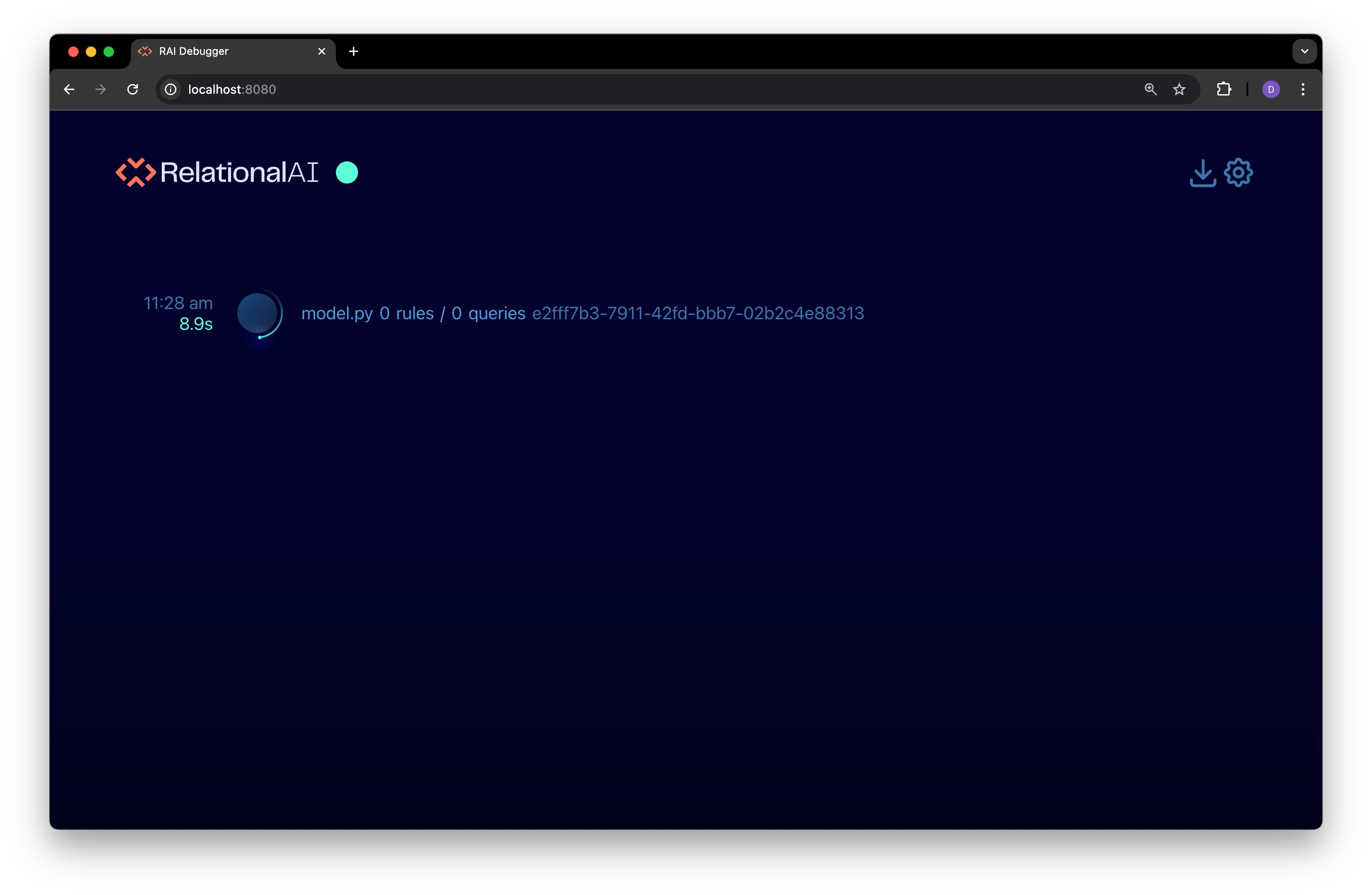
As the model executes, the timeline updates to show the execution events in chronological order:
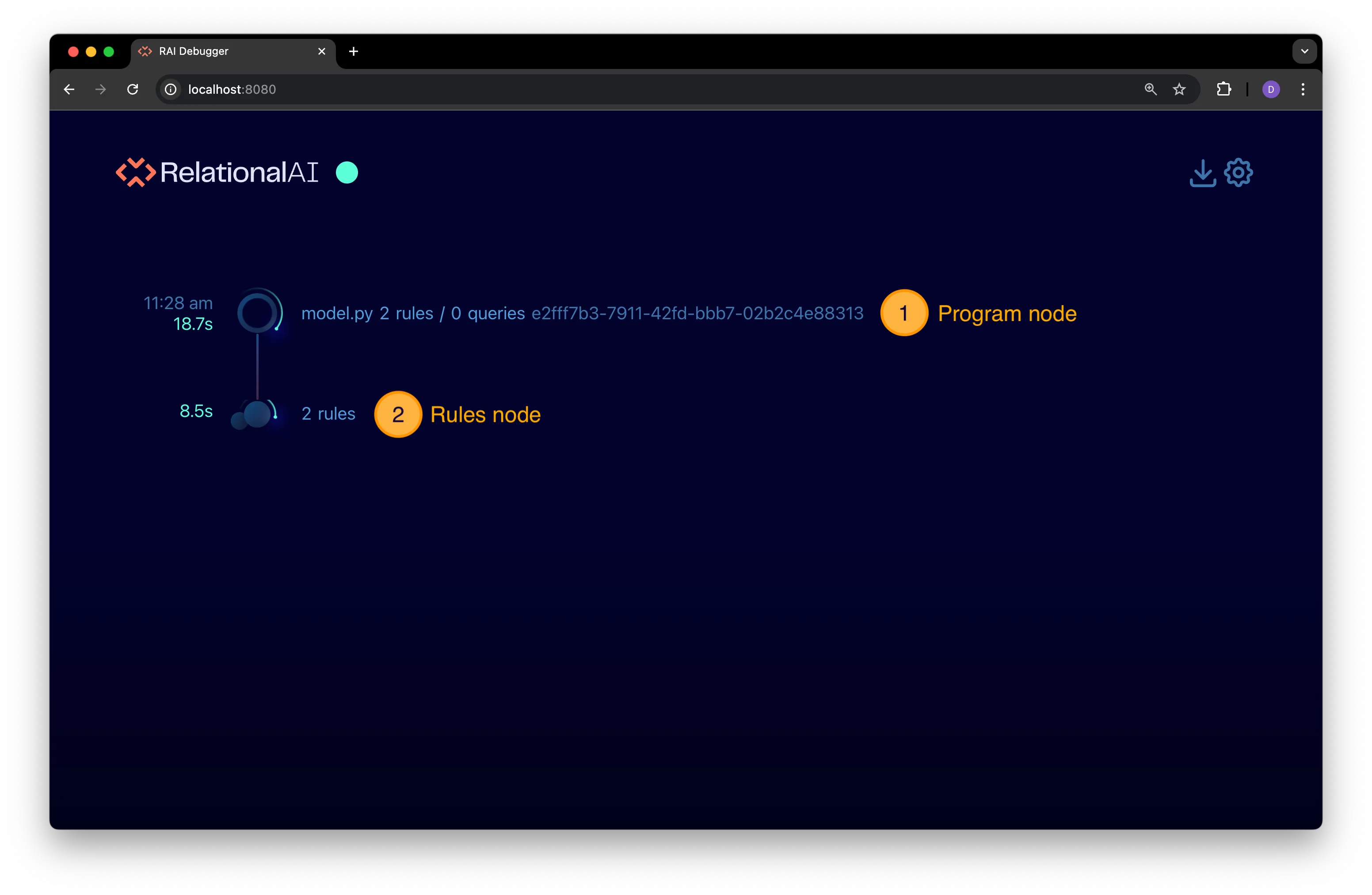
In the timeline:
- Each event is displayed as a node in the timeline.
- An event’s elapsed execution time is shown to the left of it’s timeline icon.
- Events currently being executed are indicated by an animated spinner around it’s timeline that disappears when execution is complete.
The timeline in the preceding figure has two event nodes:
-
A program node that represents the execution of a single program.
-
A rules node that represents a set of compiled rules that are being installed in the model’s configured RAI engine as part of the RAI program lifecyle.
-
Collapse and expand the program node.
Click on the program node’s timeline icon and it collapses to a compact view. The rules node disappears from the timeline because it gets folded up into its corresponding program node.
Click the program node again to return to the expanded view.
-
Explore the rules node.
Click on the rules node to open an expanded view with individual rules displayed in the timeline:
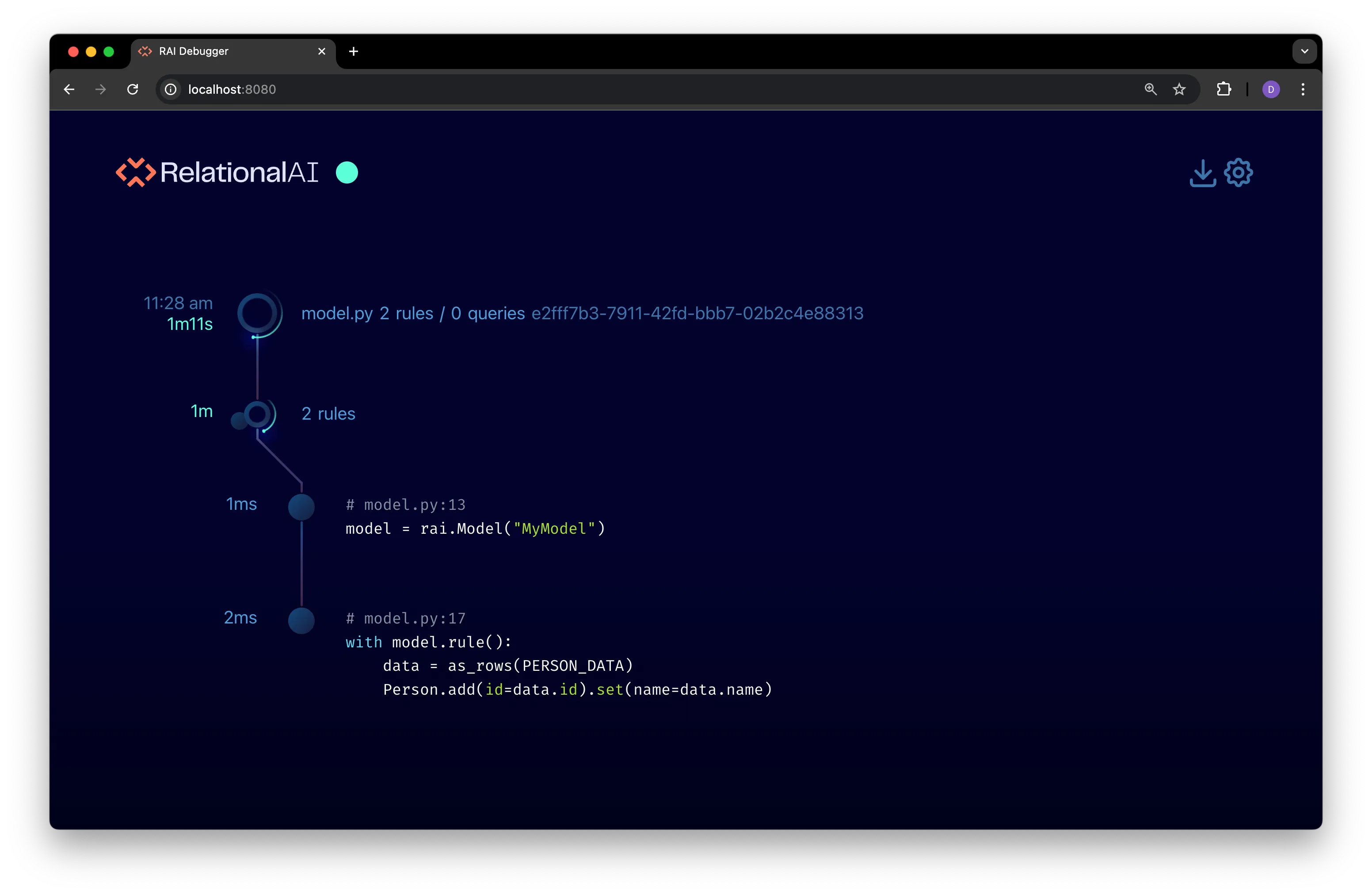
This view updates as rules are compiled and installed in the model’s configured RAI engine. See Expanded Rules View for details on all the information available in this view.
For now, click the rules node again to collapse it.
-
Explore the query node.
Once the rules are compiled, a query node is created for the
model.query()block in in themy_project/model.pyfile:
You can view the query’s code and its elapsed execution time.
Click on the query node for an expanded view that contains a transaction node with some basic profiling statistics for query:
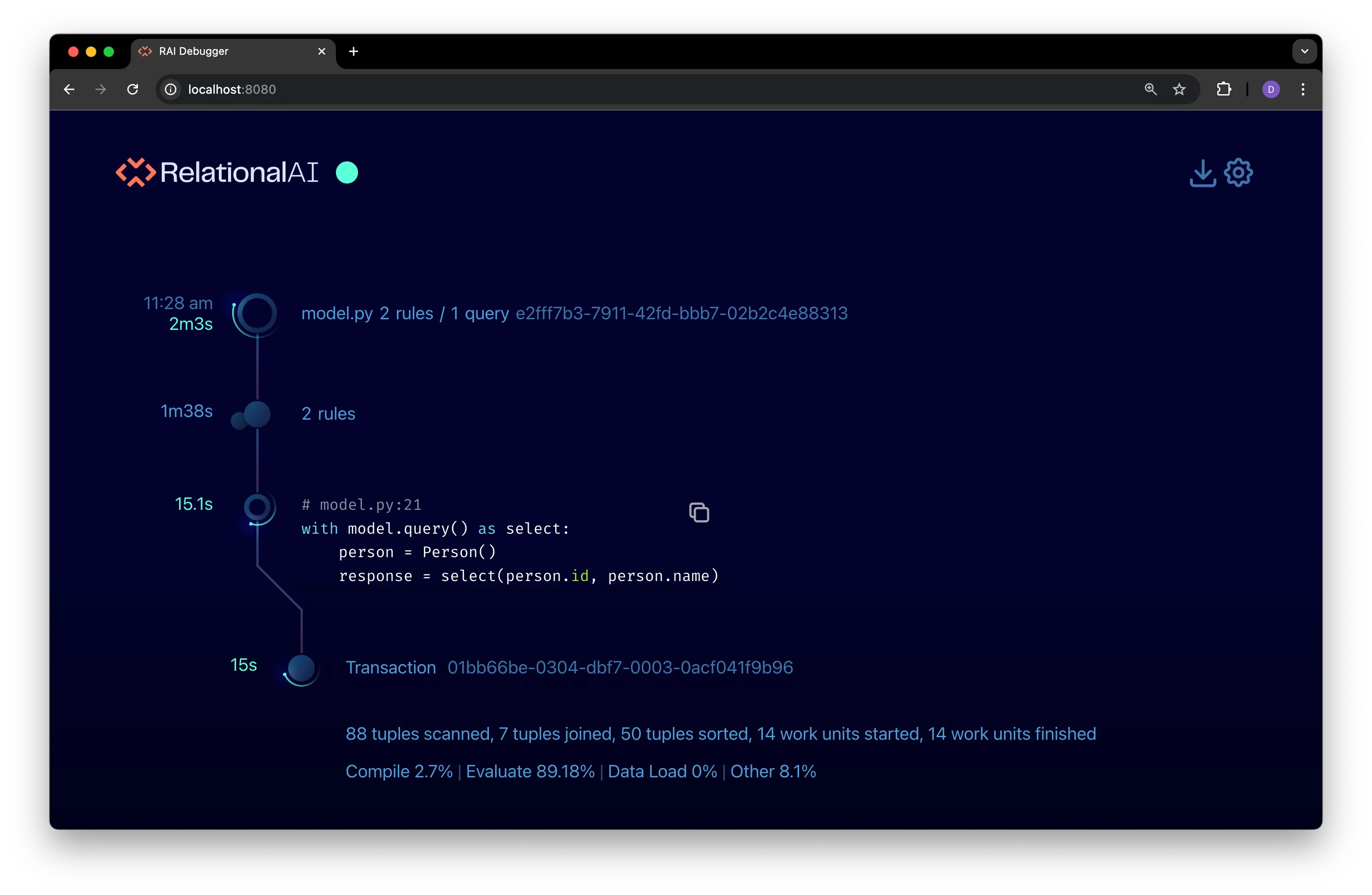
Refer to Understand Profile Stats for details on interpreting these stats.
When the query finishes, a sample of its results are displayed in the timeline:
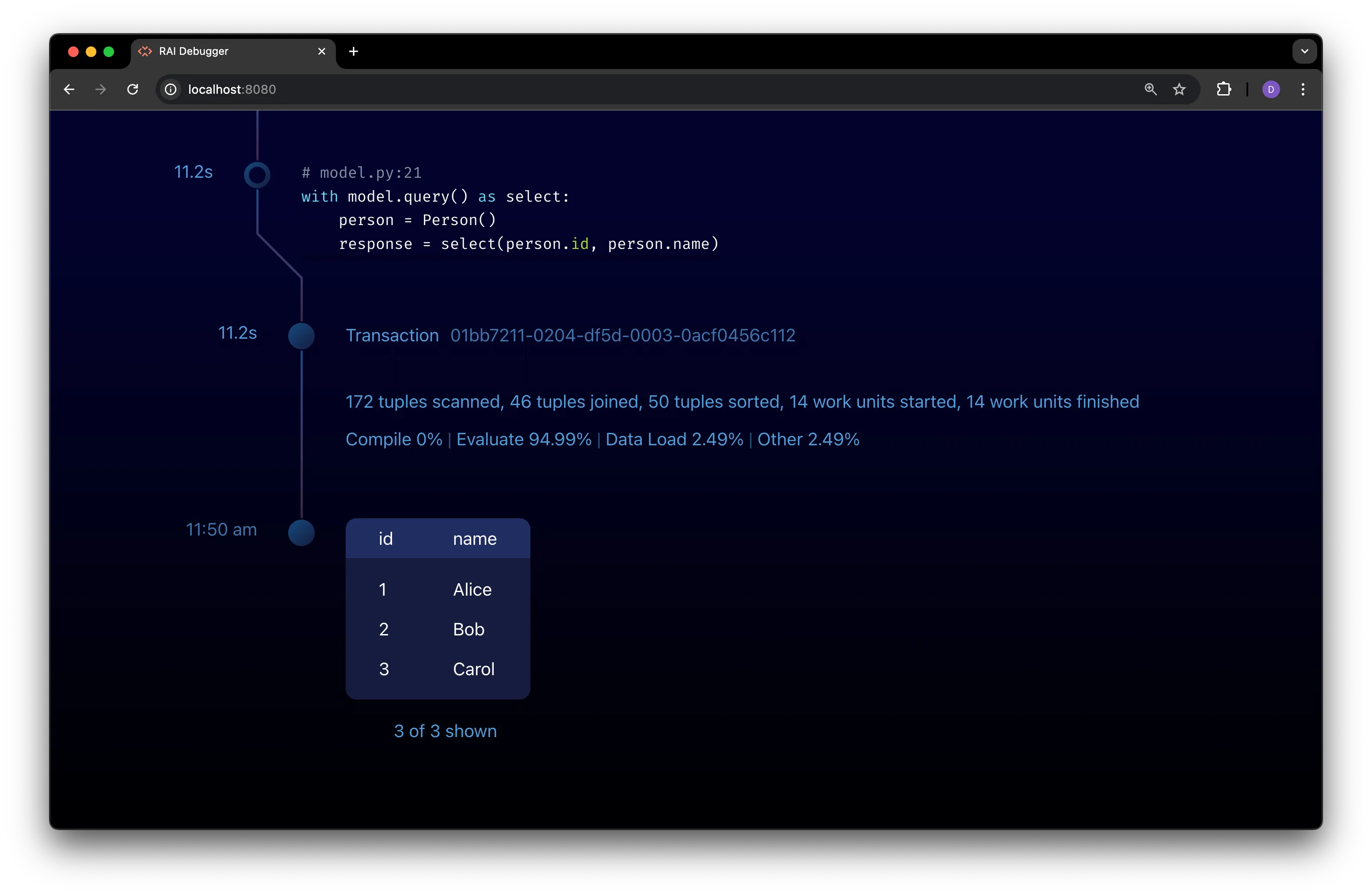
View Error Information in the Debugger
Section titled “View Error Information in the Debugger”If your program encounters an error, the debugger interface highlights the program node in orange and displays the error message in the timeline.
Follow these steps to run a program that generates an error:
-
Add new rules and queries to the program
In the
my_project/model.pyfile, add a new rule and query to the model:my_project/model.py import datetimeimport relationalai as raifrom relationalai.std import as_rows, datesPERSON_DATA = [{"id": 1, "name": "Alice"},{"id": 2, "name": "Bob"},{"id": 3, "name": "Carol"},]COMPANY_DATA = [ # <-- Added new data{"id": 1, "name": "Acme", "date_founded": datetime.date(2019, 1, 1)},{"id": 2, "name": "Globex", "date_founded": datetime.date(2020, 2, 2)},{"id": 3, "name": "Initech", "date_founded": datetime.date(2021, 3, 3)},]EMPLOYEE_DATA = [ # <-- Added new data{"person_id": 1, "company_id": 1, "start_date": datetime.date(2019, 1, 1)},{"person_id": 2, "company_id": 1, "start_date": datetime.date(2020, 2, 2)},{"person_id": 3, "company_id": 2, "start_date": datetime.date(2021, 3, 3)},]model = rai.Model("MyModel")Person = model.Type("Person")Company = model.Type("Company") # <-- Added new typeEmployee = model.Type("Employee") # <-- Added new typeFoundingEmployee = model.Type("FoundingEmployee") # <-- Added new typewith model.rule():data = as_rows(PERSON_DATA)Person.add(id=data.id).set(name=data.name)with model.query() as select:person = Person()response = select(person.id, person.name)with model.rule(): # <-- Added new ruledata = as_rows(COMPANY_DATA)Company.add(id=data.id).set(name=data.name)with model.rule(): # <-- Added new ruledata = as_rows(EMPLOYEE_DATA)Employee.add(person_id=data.person_id,company_id=data.company_id).set(start_date=data.start_date)# Define person and company properties for the Employees type that connect# employee entities directly to the person and company entities they are# related to.Employee.define( # <-- Added new propertiesperson=(Person, "id", "person_id"),company=(Company, "id", "company_id"))# An employee is a FoundingEmployee if they started working at the company# within 6 months of the company being founded.with model.rule(): # <-- Added new ruleemployee = Employee()company = Company()employee.start_date <= company.date_founded + dates.months(6)employee.set(FoundingEmployee)# Who are the founding employees?with model.query() as select: # <-- Added new queryemployee = FoundingEmployee()response = select(employee.person.name, employee.company.name)print(response.results) -
Run the program.
Save and run the edited
model.pyfile:Terminal window python model.pyA new program node appears in the debugger interface:
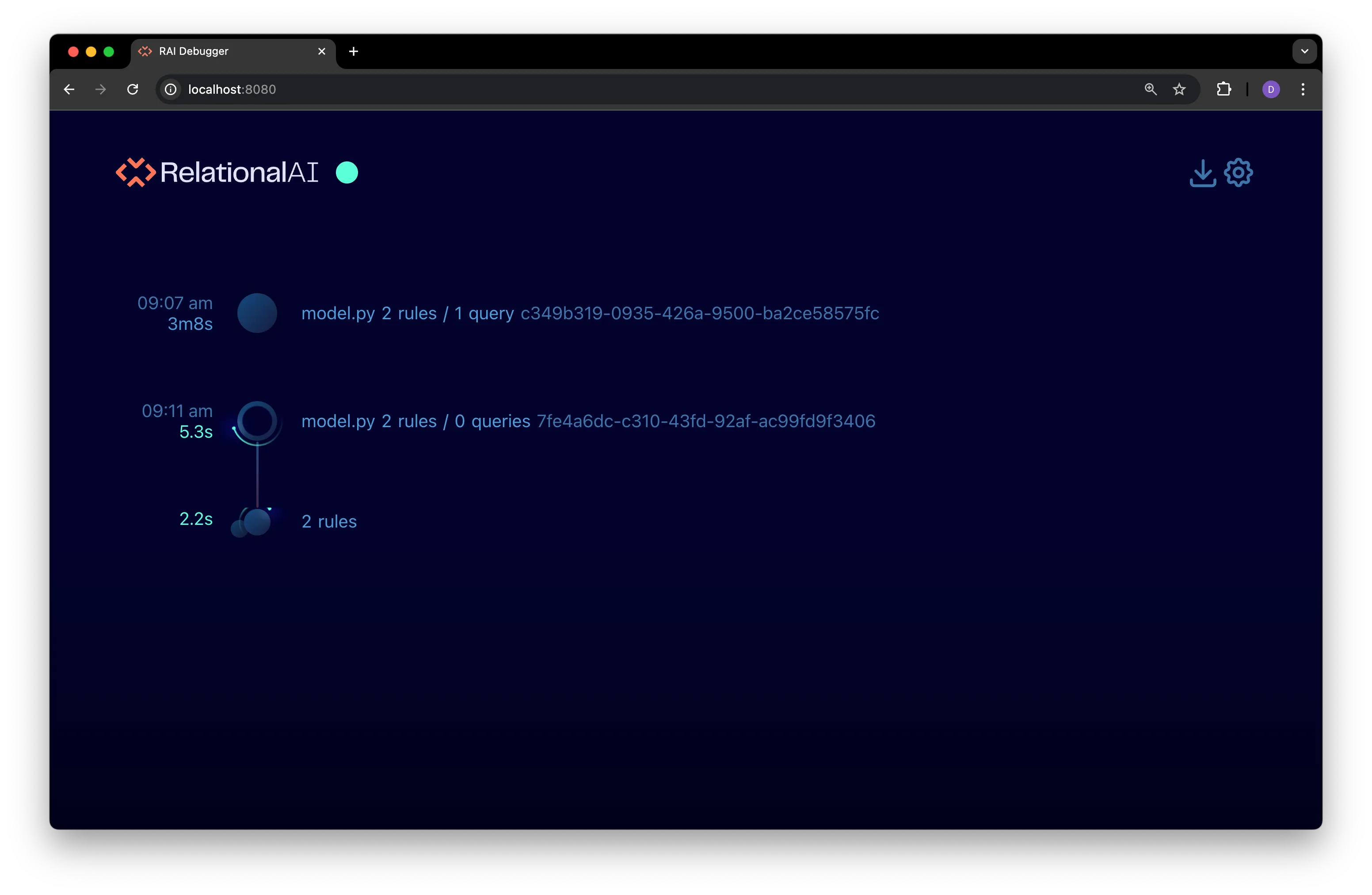
The second query in the new program encounters an error, which is indicated in the timeline by highlighting the query node in orange. The program node is also highlighted in orange to indicate that an error occurred during its execution:
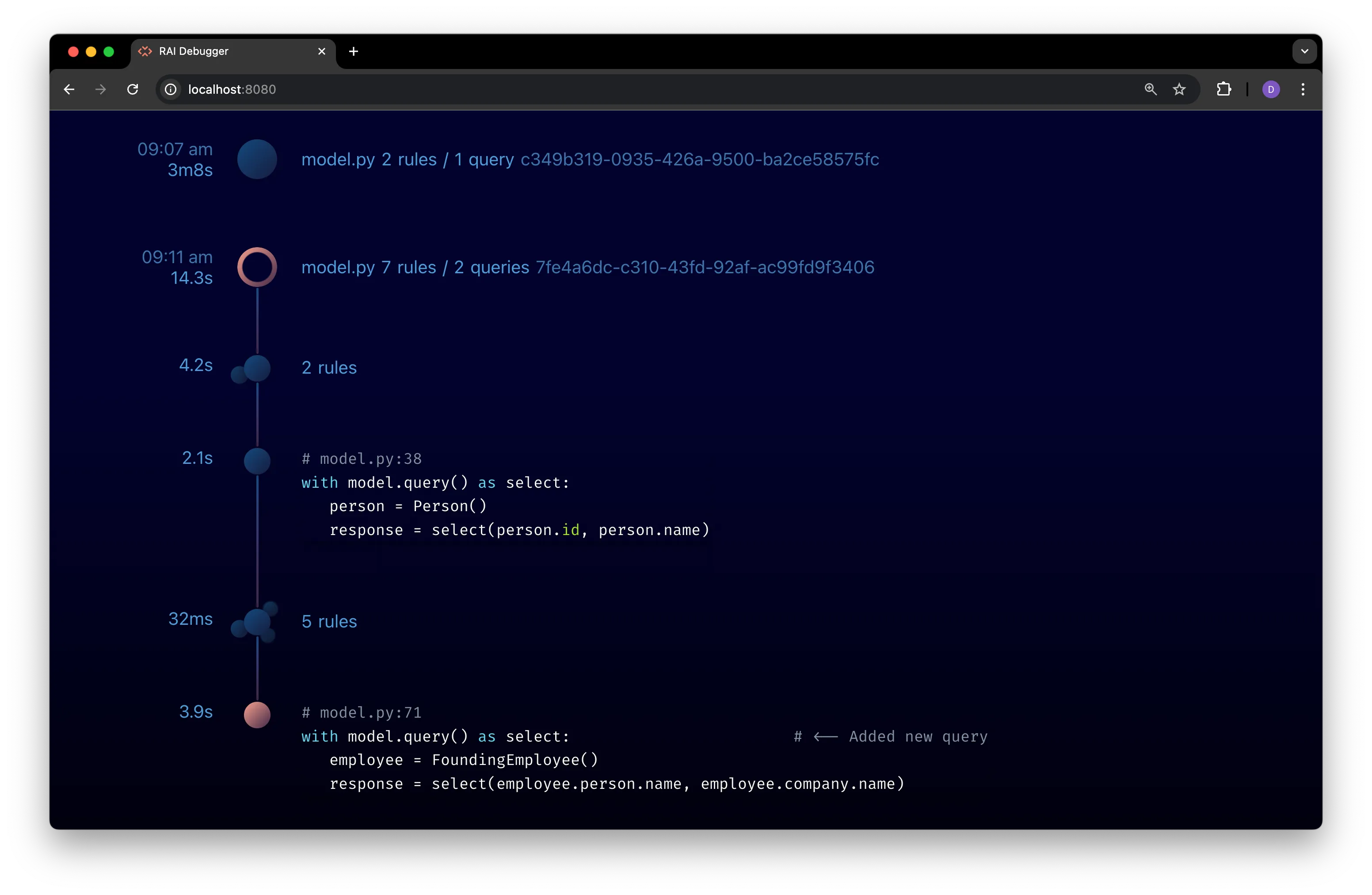
Note the order of events in the timeline:
- The program node is created.
- A rules node for 2 nodes is created.
- The first query is executed.
- A rules node with 3 nodes is created.
- The second query is executed, which causes an error.
The program executes queries in the order that they appear in the code, and only the rules created before the query is executed are available to the query. The first query only uses the 2 rules created before it, while the second query uses all 8 rules.
See The RAI Program Lifecycle for more details about the execution model.
-
View the error.
Click on the highlighted query node’s timeline icon to view the error message:

The detailed view shows the following information about the error:
-
The error message. In the preceding figure, the error message tells you that the
date_foundedproperty has never been set forCompanyentities. -
The filename and line number of the rule or query that generated the error. In the preceding figure, the error came from line 64 of the
model.pyfile. -
The source code for the rule or query that generated the error. The code for the new query added to the program in Step 1 is displayed in the preceding figure.
-
-
Fix the error.
The dictionaries in the
COMPANY_DATAlist defined at the top of themodel.pyfile have adate_foundedkey with the date each company was founded:COMPANY_DATA = [{"id": 1, "name": "Acme", "date_founded": datetime.date(2019, 1, 1)},{"id": 2, "name": "Globex", "date_founded": datetime.date(2020, 2, 2)},{"id": 3, "name": "Initech", "date_founded": datetime.date(2021, 3, 3)},]However, the rule defines
Companyentities from the data does not set adate_foundedproperty:# Original rulewith model.rule():data = as_rows(COMPANY_DATA)Company.add(id=data.id).set(name=data.name) # <-- No date_founded property is set.To fix the error, edit the rule to set the
date_foundedproperty forCompanyentities:# Edited rulewith model.rule():data = as_rows(COMPANY_DATA)Company.add(id=data.id).set(name=data.name,date_founded=data.date_founded # <-- Set date_founded property) -
Re-run the program to check that the error is resolved.
Save and run the edited
model.pyfile again. A third program node appears in the timeline. This time, the program completes without an error: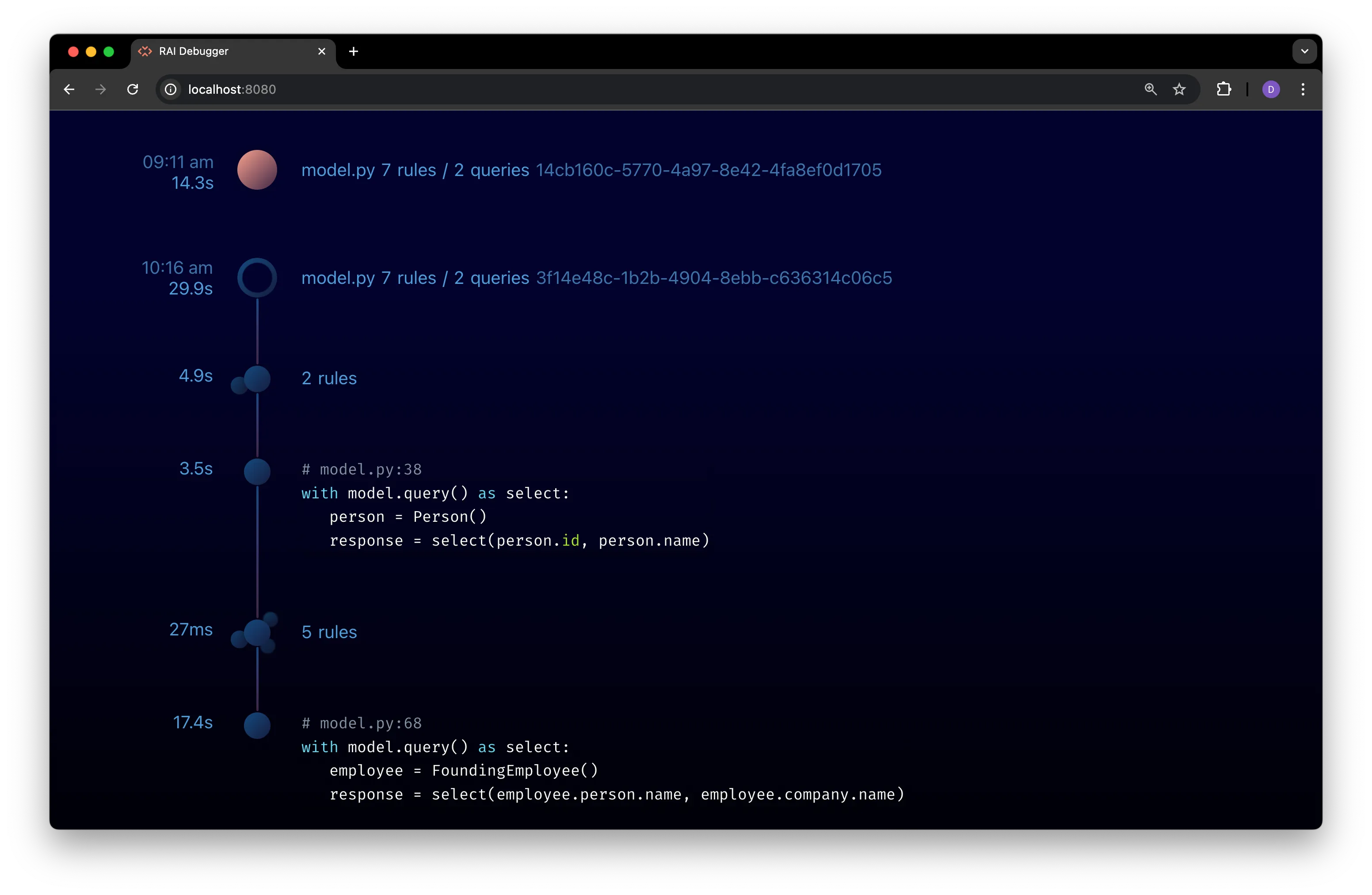
Debug a Query With Unexpected Results
Section titled “Debug a Query With Unexpected Results”Although the program completes without error, something still isn’t quite right.
-
Expand the query node to view query results.
Click on the query node’s timeline icon to expand it and view the results of the query:
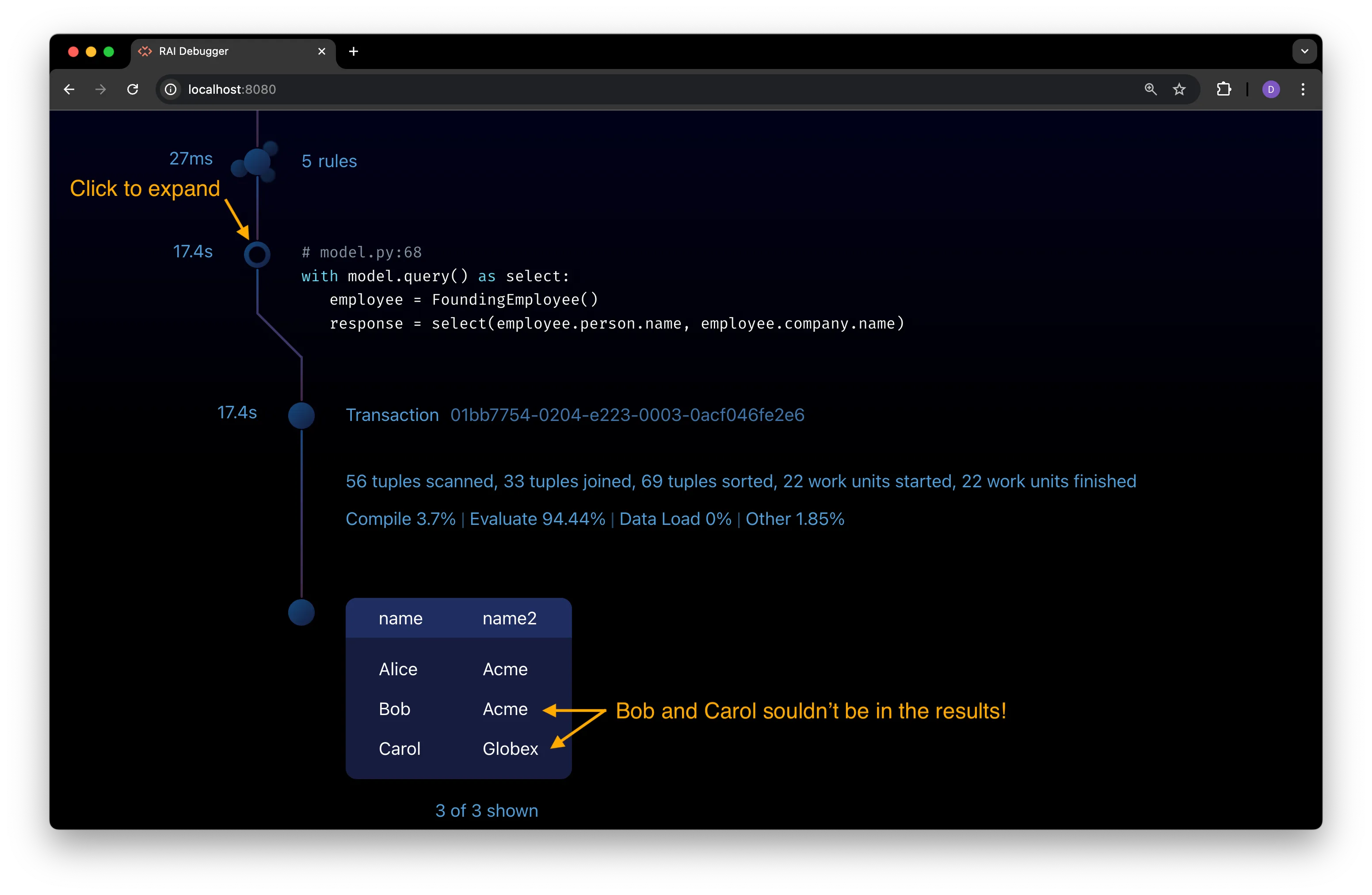
The query returns the names of employees and companies where the employee is a founding employee of the company.
According to the following rule, an employee is a founding employee if they started working at the company within 6 months of the company being founded:
with model.rule():employee = Employee()company = Company()employee.start_date <= company.date_founded + dates.months(6)employee.set(FoundingEmployee)Bob isn’t a founding employee of Acme. He joined on February 2, 2021, over a year after the company was founded on January 1, 2020. In fact, Carol shouldn’t be a founding employee of Globex, either!
Something is wrong with the rule, but what?
-
Expand the transaction node to view query execution details.
Click on the transaction node to expand it:
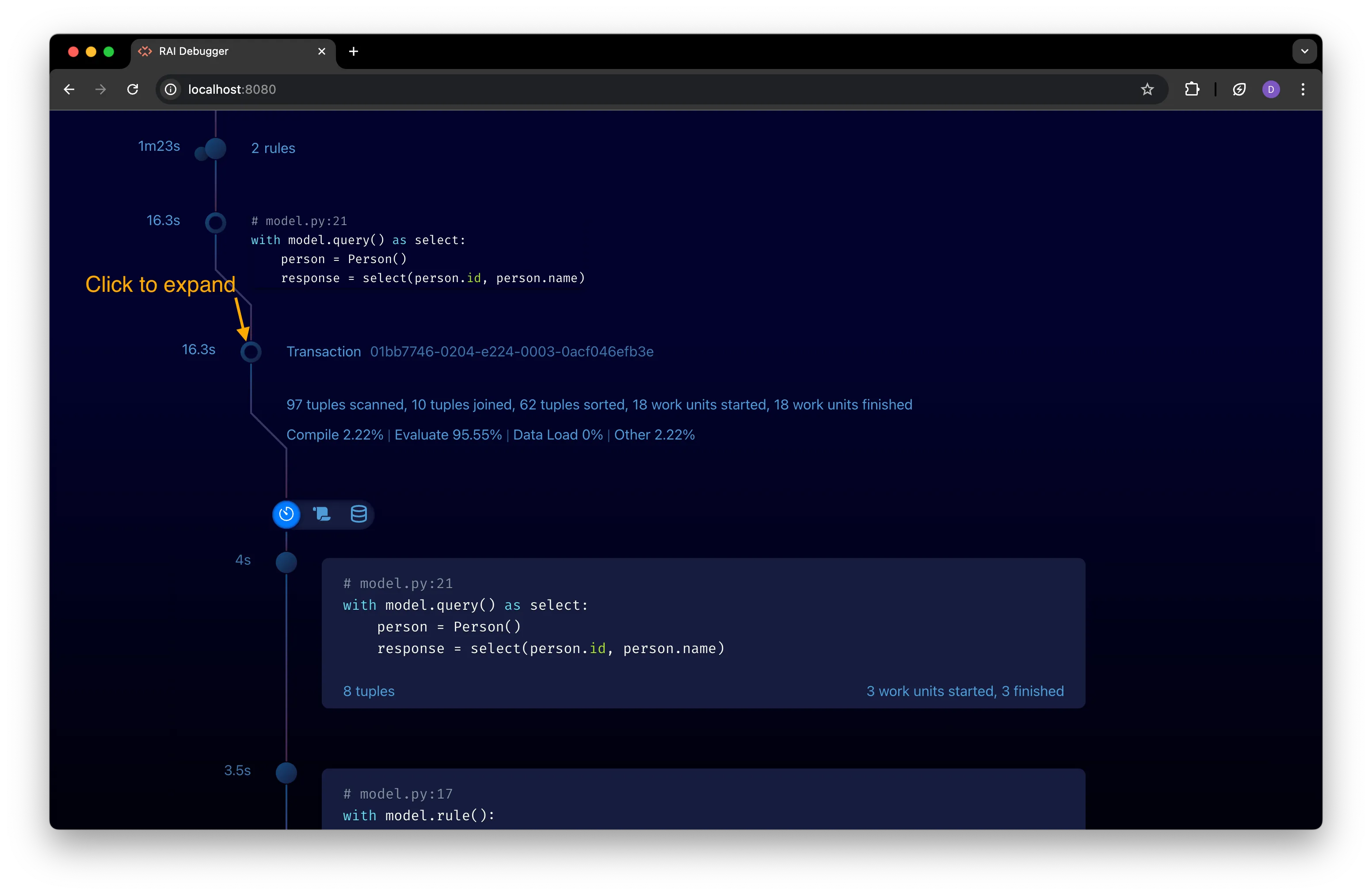
In the expanded view, you see each rule used to evaluate the query. Hover your mouse over a rule’s code to view all stats for the rule:

See View Query Execution Details to learn how to interpret these stats.
-
Scan the rule blocks for issues.
Scroll through the rules to see if any issues jump out to you.
The rule that assigns
Employeeentities to theFoundingEmployeetype has a warning icon in the bottom right corner: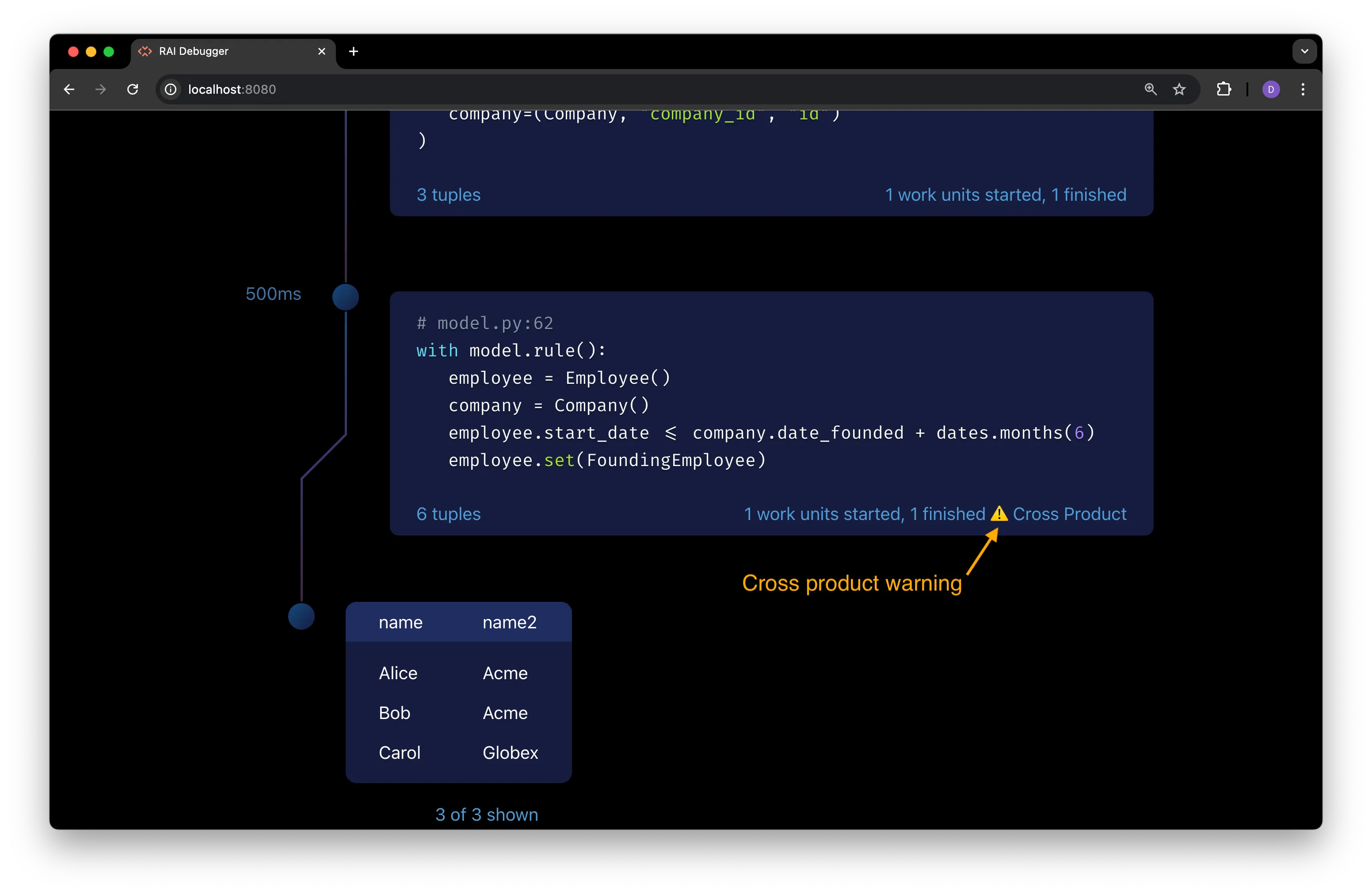
This is a cross product warning. The
employeeandcompanyvariables have no constraint relating one to the other, so all possible pairs of employees and companies are being evaluated in the rule:with model.rule():employee = Employee()company = Company() # <-- There is no condition that relates employee and companyemployee.start_date <= company.date_founded + dates.months(6)employee.set(FoundingEmployee)Bob gets paired with Globex, even though he doesn’t work there, and his start date is within 6 months of Globex’s founding date, so he is incorrectly assigned to the
FoundingEmployeetype. -
Fix the cross product.
Add a condition to the rule that relates the
employeeandcompanyvariables:with model.rule():employee = Employee()company = Company()employee.company_id == company.id # <-- Add condition to relate employee and companyemployee.start_date <= company.date_founded + dates.months(6)employee.set(FoundingEmployee)Alternatively, you can reference the employee’s
companyproperty directly:with model.rule(): # Get employee's company propertyemployee = Employee() # /# ∨∨∨∨∨∨∨∨∨∨∨∨∨∨∨∨employee.start_data <= employee.company.date_founded + dates.months(6)employee.set(FoundingEmployee)See Interpret Cross Product Warnings for more details about cross products and how to fix them.
-
Re-run the program to check that the query works as expected.
Save and run the edited
model.pyfile again. The query now returns the expected results: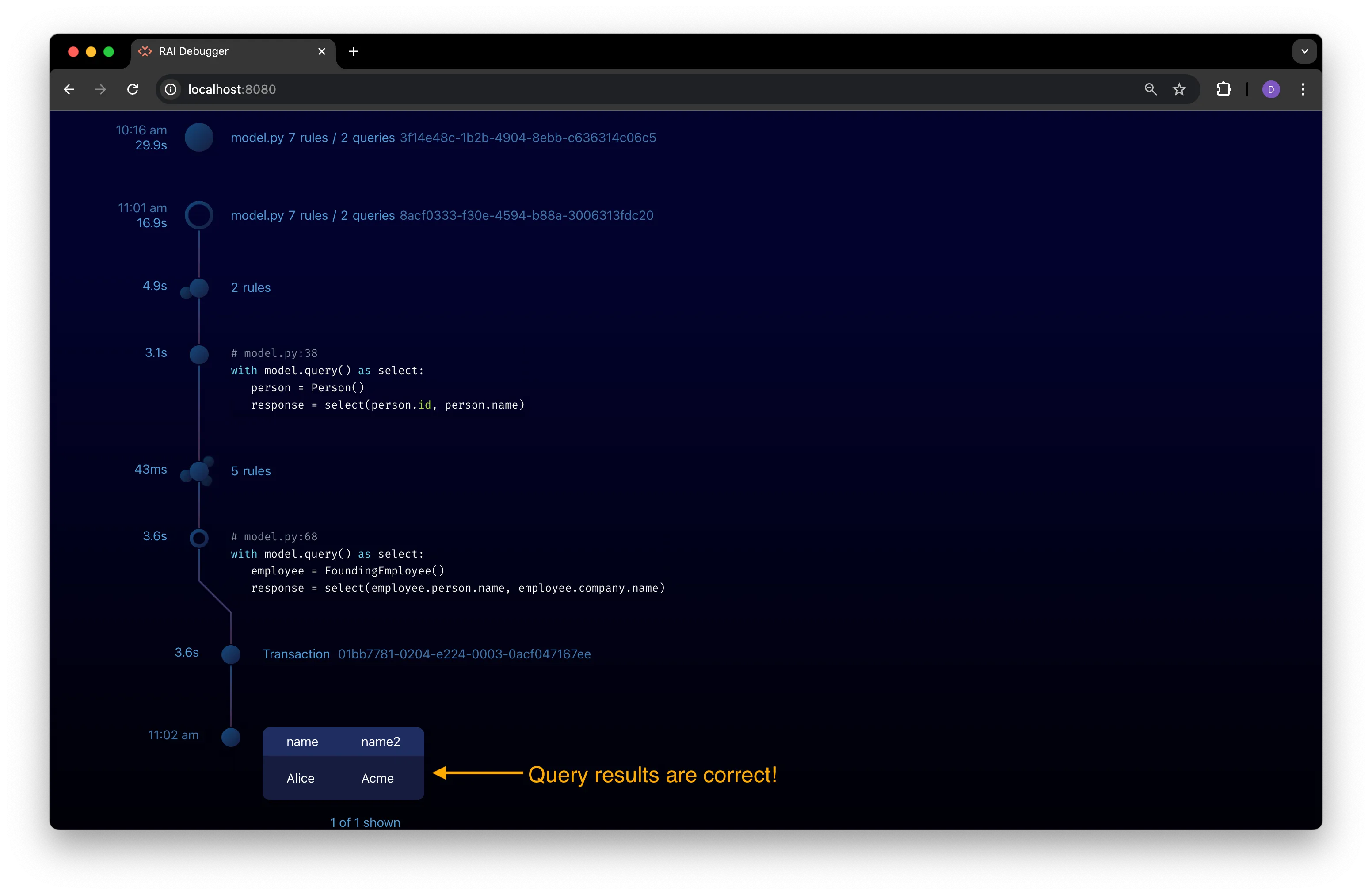
Export Detailed Debugger Logs
Section titled “Export Detailed Debugger Logs”If necessary, you can export events logged by the debugger to share with RelationalAI support or to send to someone else to help debug your program.
To export a log file, scroll to the very top of the debugger interface in your browser and click on the Export events button in the top right corner to the left of the gear icon:
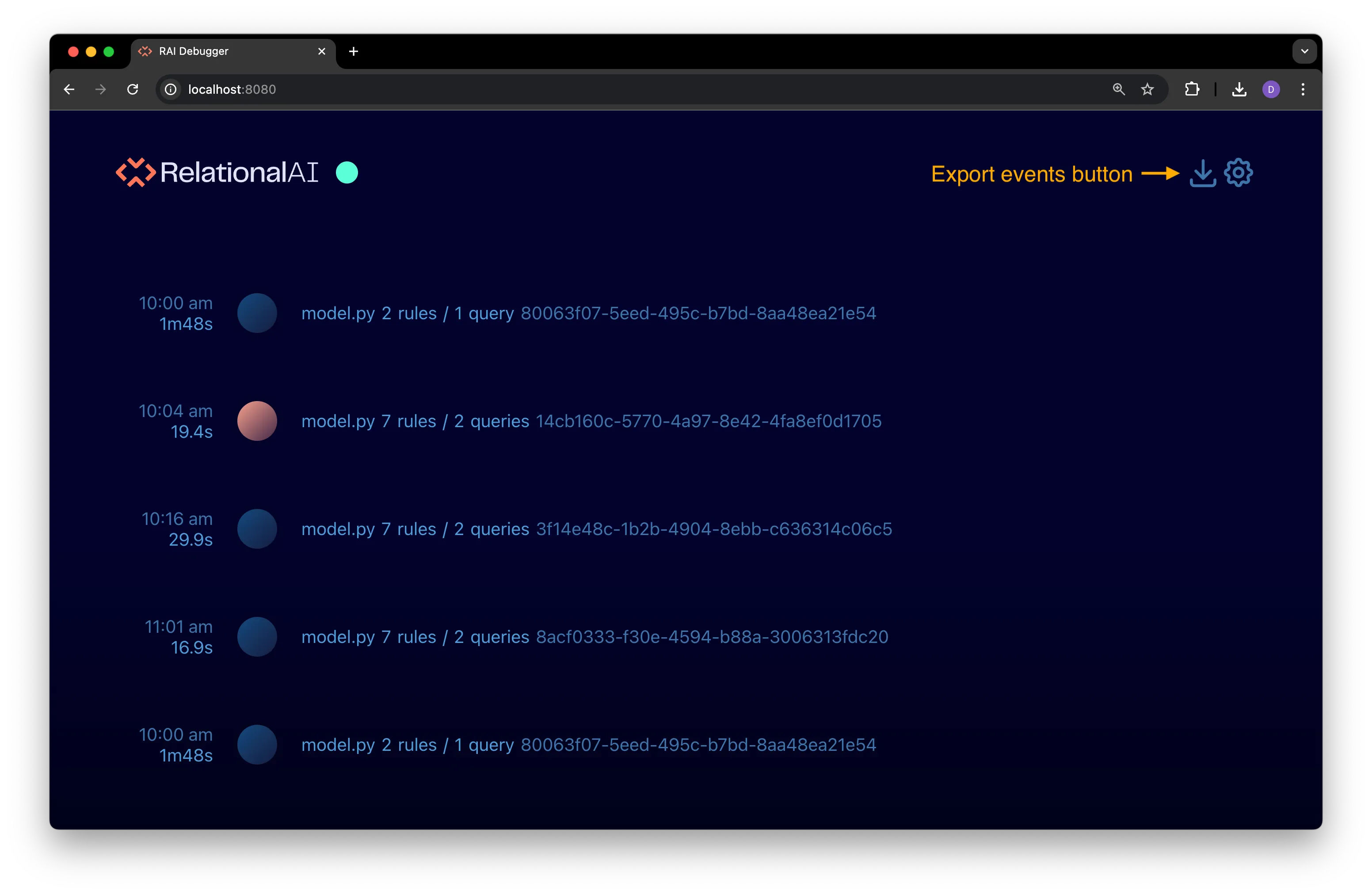
The file is saved as debugger_data.json to the same directory where you started the debugger server.
You can open the file in a text editor or JSON viewer to see the raw log data.
, and may share the file with others.
Load an Exported Log File
Section titled “Load an Exported Log File”To view an exported debugger log, drag and drop the debugger_data.json file onto the debugger interface.
The debugger timeline is cleared and the contents of the file are rendered in the interface as a new timeline.
Use the Debugger With a Jupyter Notebook
Section titled “Use the Debugger With a Jupyter Notebook”The debugger can be used to view programs run in Jupyter notebooks. After you’ve started the debug server, you can start a Jupyter notebook server in a separate terminal window and execute cells from a notebook.
The timeline for the notebook is displayed in the debugger interface:
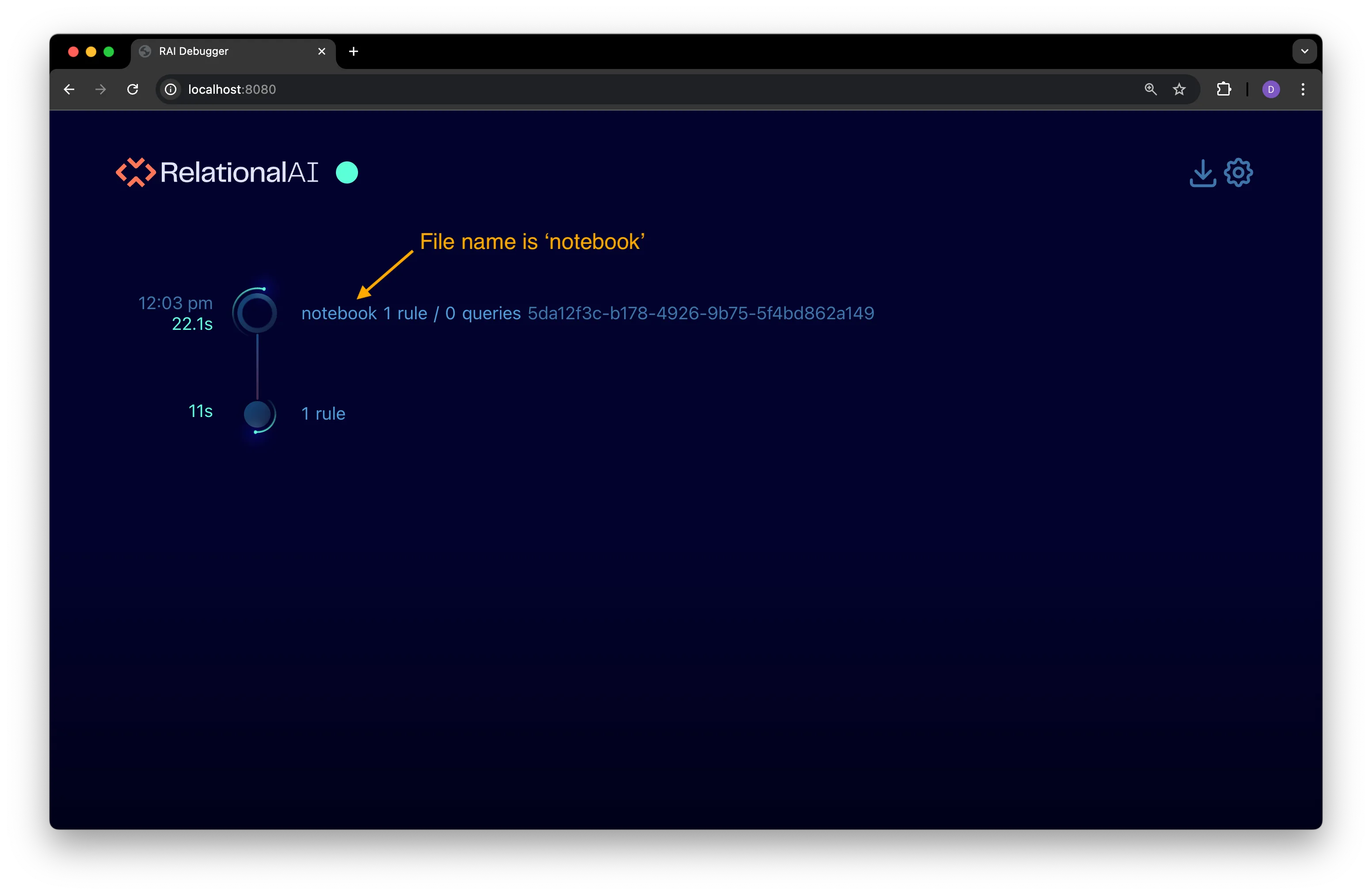
Note that:
-
A program node only appears when a cell calls the
Modelconstructor. Until that cell is executed, the debugger timeline might be empty. -
The file name displayed with the program node is
notebook(see preceding figure). -
The program node is shown as running—indicated by a bright green spinner around its timeline icon like the preceding figure—as long as the Jupyter kernel is running.
-
Restarting the Jupyter kernel and re-running the notebook creates a new program node in the timeline.
Understand the Debugger Interface
Section titled “Understand the Debugger Interface”The RAI debugger displays events logged during a program’s execution as a timeline in a web browser window. The timeline has several different components, including:
- A main menu with buttons to export events, clear the timeline, and open the settings panel.
- Program nodes that represent the execution of a program and expand to show a detailed timeline of the program’s execution.
- Rules nodes that represent the compilation of rules in the program and expand to show details about the rules.
- Query nodes that represent the execution of queries in the program and expand to show details about the query execution.
- Transaction nodes that represent the execution a transaction on a RAI engine and provide profiling statistics for the transaction.
Main Menu
Section titled “Main Menu”The main menu is located in the top right-hand corner of the debugger interface:
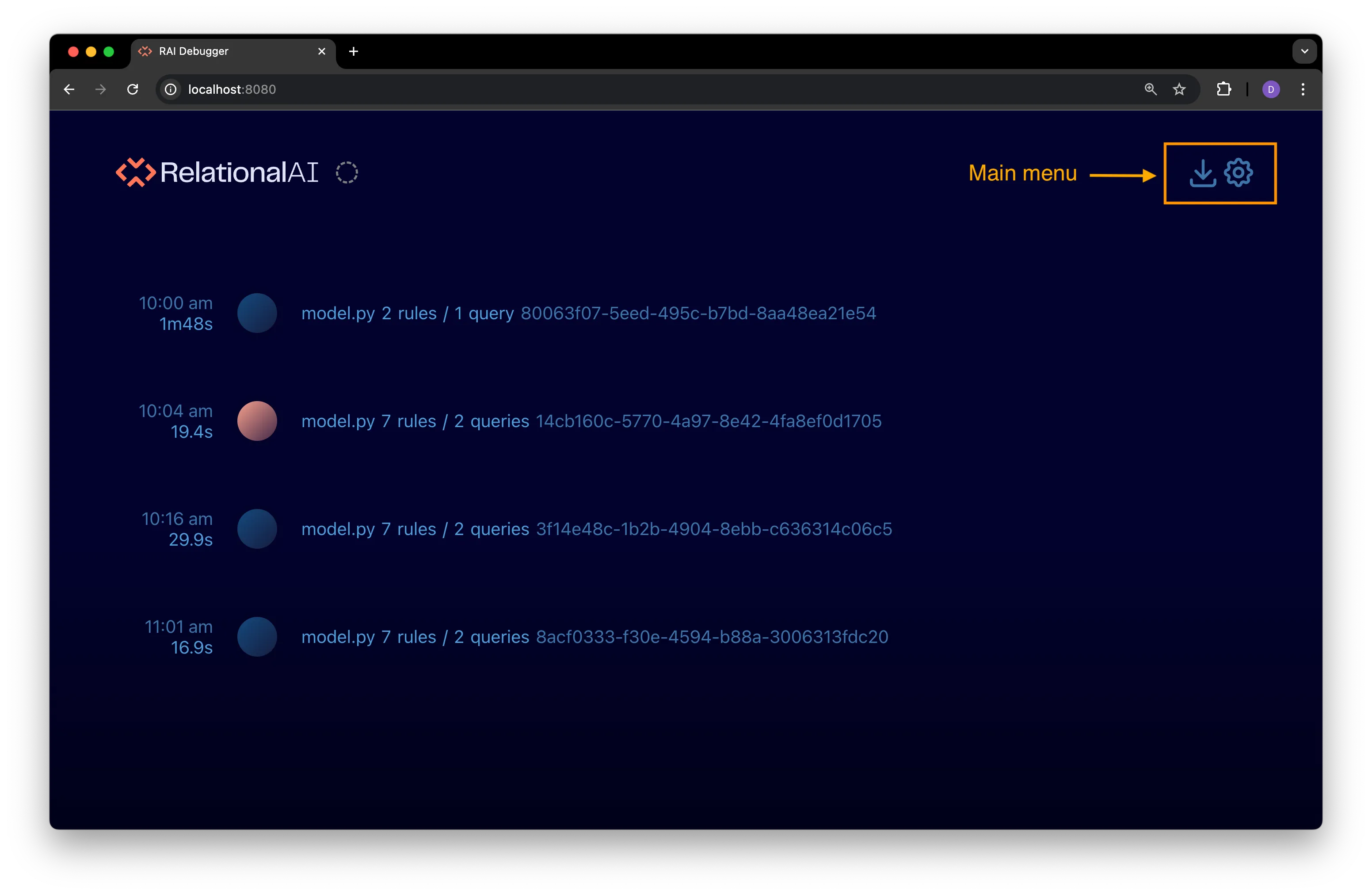
Hovering over the main menu exposes the following buttons:
Settings Button
Section titled “Settings Button”
Click on the settings button to open the settings panel:
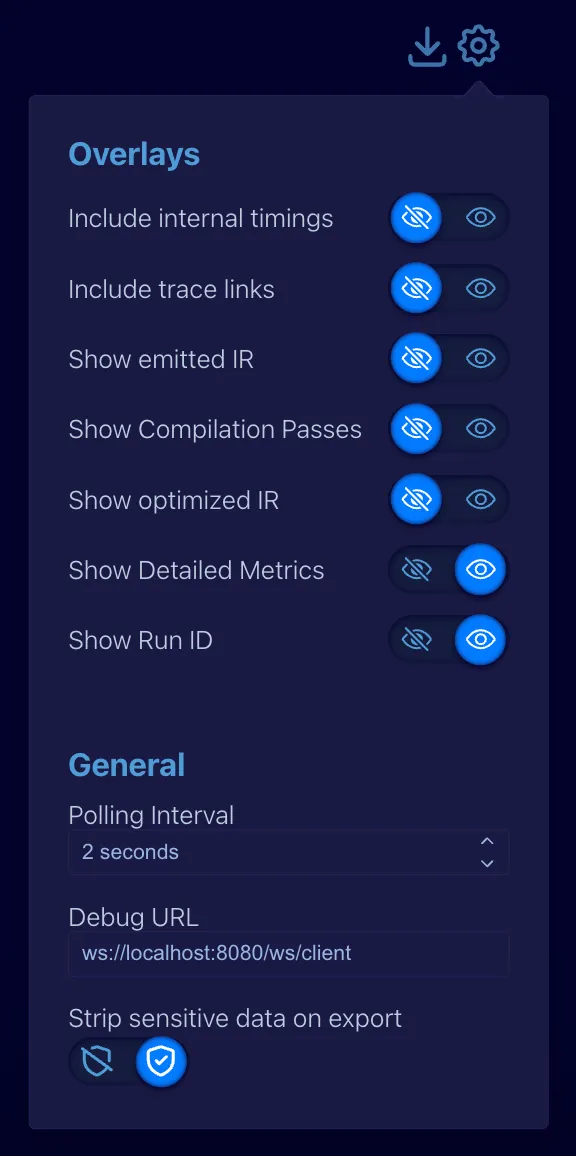
This panel has switches to enable or disable a number or options. The recommended settings are shown in the preceding figure, with everything disabled except for the Show Run ID options. Most other options are meant for internal use by RelationalAI support.
The Overlay options allow you to toggle between more or less detailed views of the timeline. Bolded settings in the table below are the recommended settings for most users:
| Option | Description | Default |
|---|---|---|
| Include internal timings | When enabled, the timeline includes timing information for internal operations. Intended for RAI support use only. | Disabled |
| Include trace links | When enabled, shows trace links in the timeline. Intended for RAI support use only. | Disabled |
| Show emitted IR | When enabled, shows compiled IR for rules and queries. Intended for RAI support use only. | Disabled |
| Show compilation passes | When enabled, includes detailed compilation information. Intended for RAI support use only. | Disabled |
| Show optimized IR | When enabled, shows additional information about the compiled IR. Intended for RAI support use only. | Disabled |
| Show Detailed Metrics | When enabled, shows detailed information and profile stats for rules and queries. Intended for RAI support use only. | Disabled |
| Show Run ID | When enabled, shows the unique Run ID for the program. | Enabled |
General options include:
| Option | Description | Default |
|---|---|---|
| Polling interval | The interval in seconds at which the debugger checks for new events. | 2 seconds |
| Debug URL | The debug server URL. | ws://localhost:8080/ws/client |
| Strip sensitive data on export | When enabled (shield with check mark icon), sensitive data is removed from the log file exported when you click the Export events button so that logs are safe to share with RAI support. | Enabled |
Export Events Button
Section titled “Export Events Button”
Click the Export events button to export a file named debugger_data.json with all of the events logged by the debugger.
See Export Detailed Debugger Logs for details.
Follow Last Run Button
Section titled “Follow Last Run Button”
Click the Follow last run button to ensure that the most recent run is always expanded in the timeline.
Clear Events Button
Section titled “Clear Events Button”
Click the Clear events button to clear the debugger timeline.
Program Nodes
Section titled “Program Nodes”Program nodes are shown on the execution timeline with a large dot icon:

Compact Program View
Section titled “Compact Program View”In the default compact view, the program node shows:
- The timestamp when the program started executing.
- The elapsed time for the program to execute.
- The number of rules and queries that have been compiled during the program’s execution.
- The unique Run ID for the program.
A program node highlighted in orange indicates that an error occurred during the program’s execution. See View Error Information in the Debugger to learn how to view error messages.
Expanded Program View
Section titled “Expanded Program View”Click on a program node’s timeline icon for an expanded view with all of the rules nodes and query nodes associated with the program’s execution:
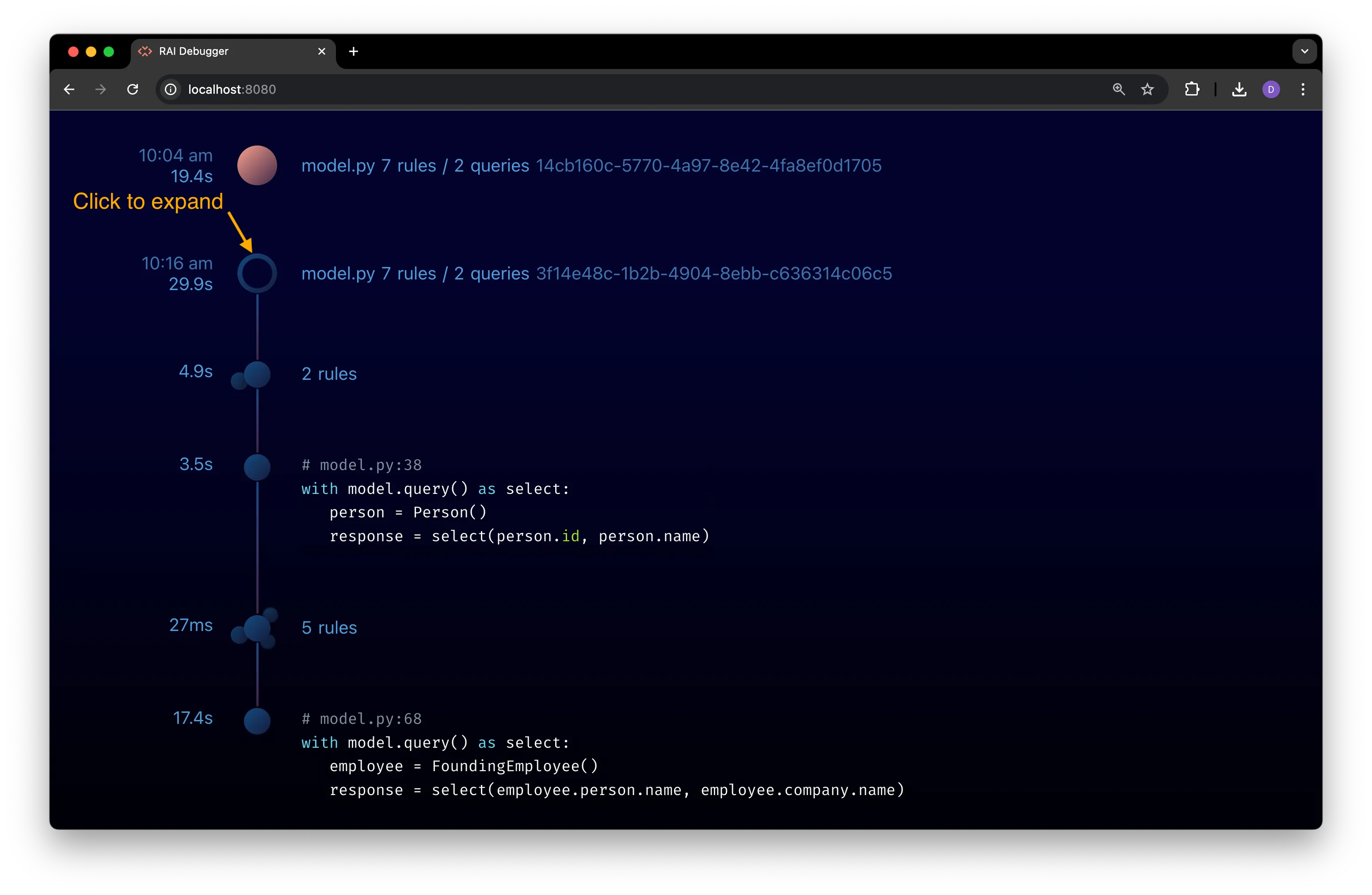
Rules Nodes
Section titled “Rules Nodes”Rules are shown on the execution timeline with an icon that looks like multiple dots. In the following example, the timeline has two rules that have been compiled:
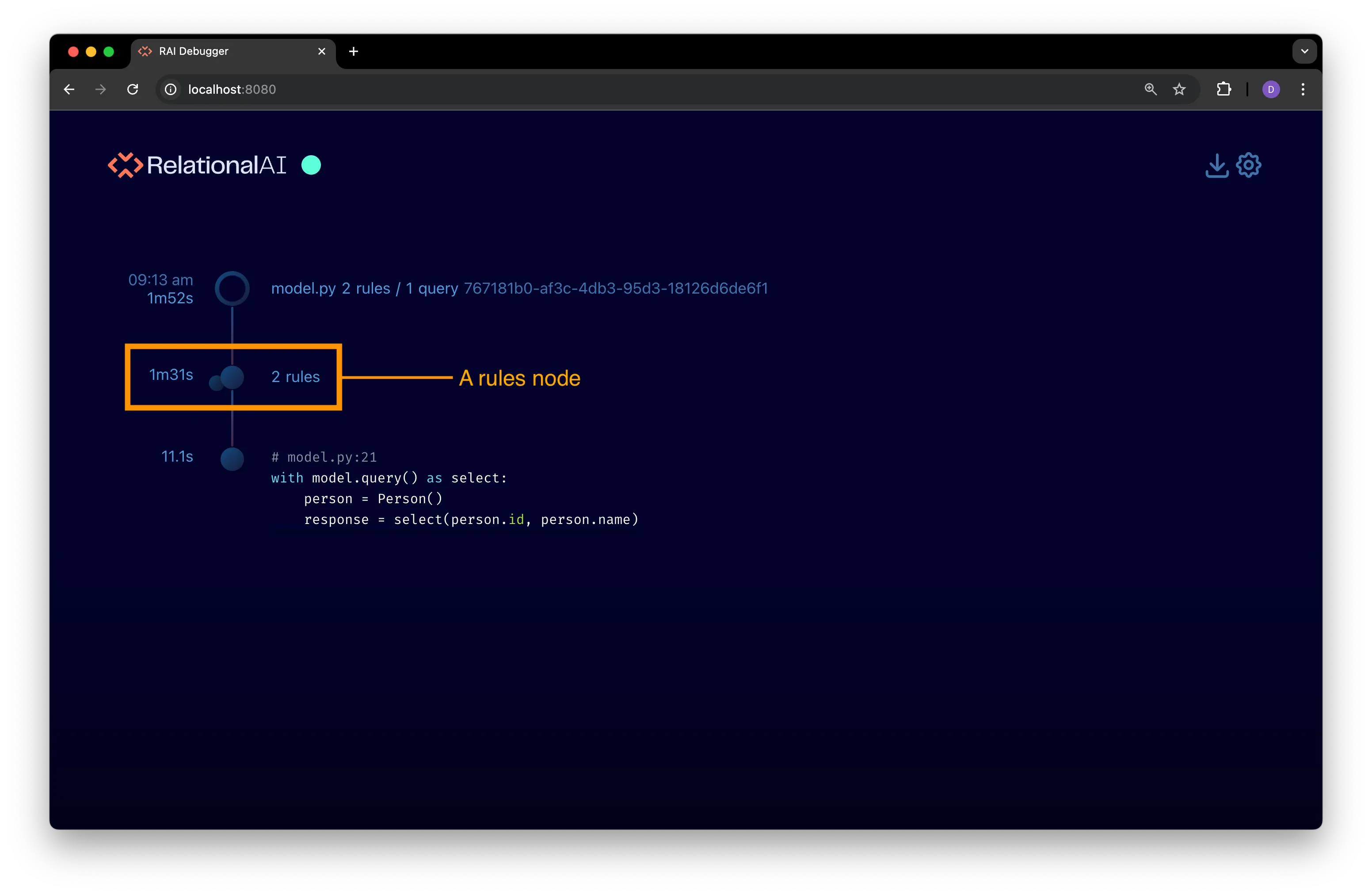
Compact Rules View
Section titled “Compact Rules View”You can view the following information in the default compact node view:
- The total compilation time for the rules to the left of the node.
- The number of rules that have been compiled to the right of the node.
Expanded Rules View
Section titled “Expanded Rules View”Click the dot next to a rules node to expand it and view details about the rules that have been compiled:

The expanded view shows:
-
The code for each rule along with its compilation time and the filename and line number where the rule was defined.
-
A transaction node with the total elapsed transaction time and the transaction’s unique ID.
-
Several profile statistics for the transaction’s execution. See Understand Profile Stats to learn how to interpret these stats.
-
An installation node that can be expanded to view details about the compiled rules. See View Rule Compilation Details for details.
Query Nodes
Section titled “Query Nodes”Query nodes are shown on the execution timeline as a single dot with the query’s code next to it:
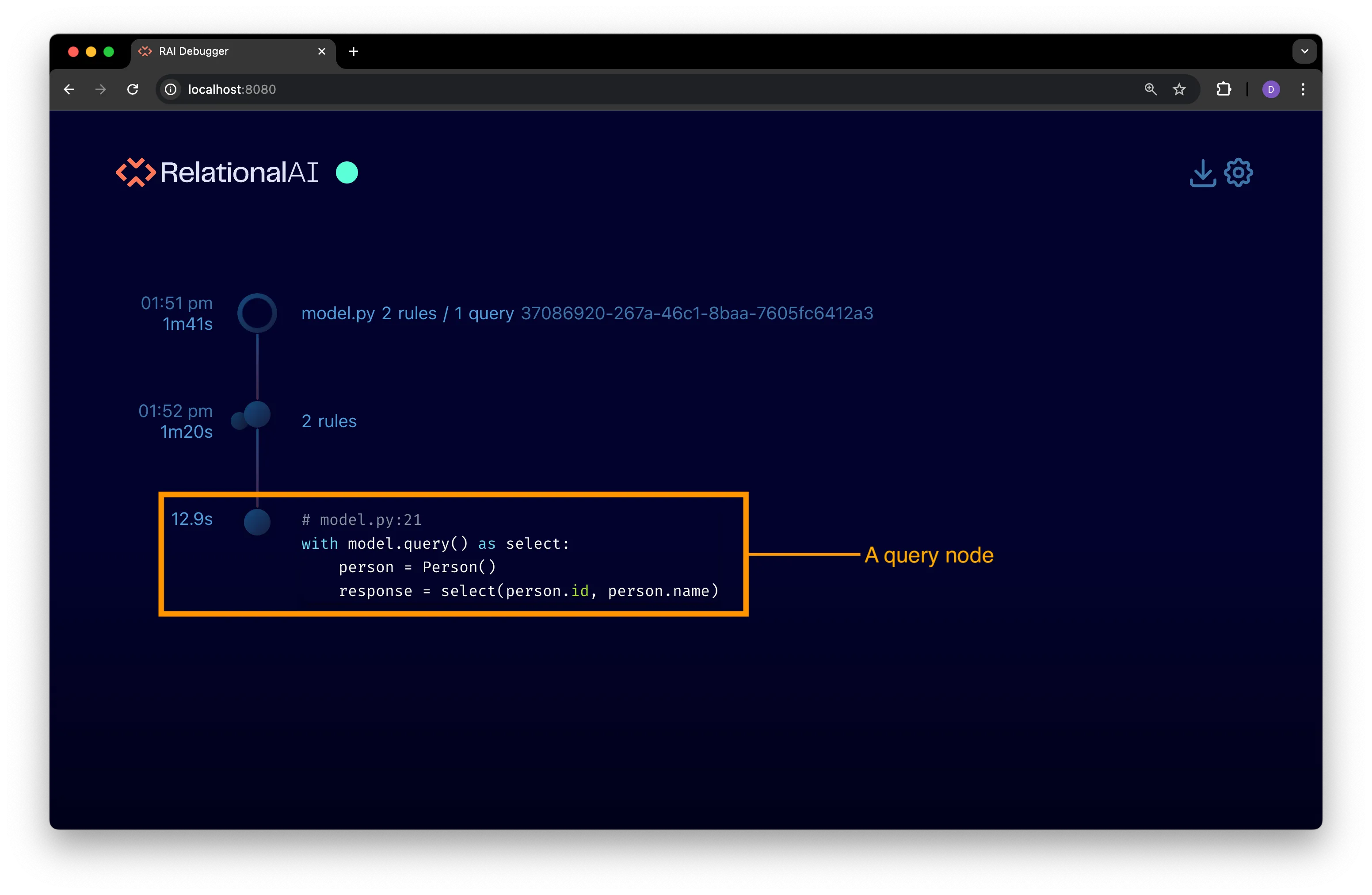
Compact Query View
Section titled “Compact Query View”With the default compact node view (see preceding figure) you can see:
- The total elapsed query execution time.
- The query’s code and the filename and line number where the query was defined.
Expanded Query View
Section titled “Expanded Query View”Click on a query node for an expanded node view with details about the query and its execution:
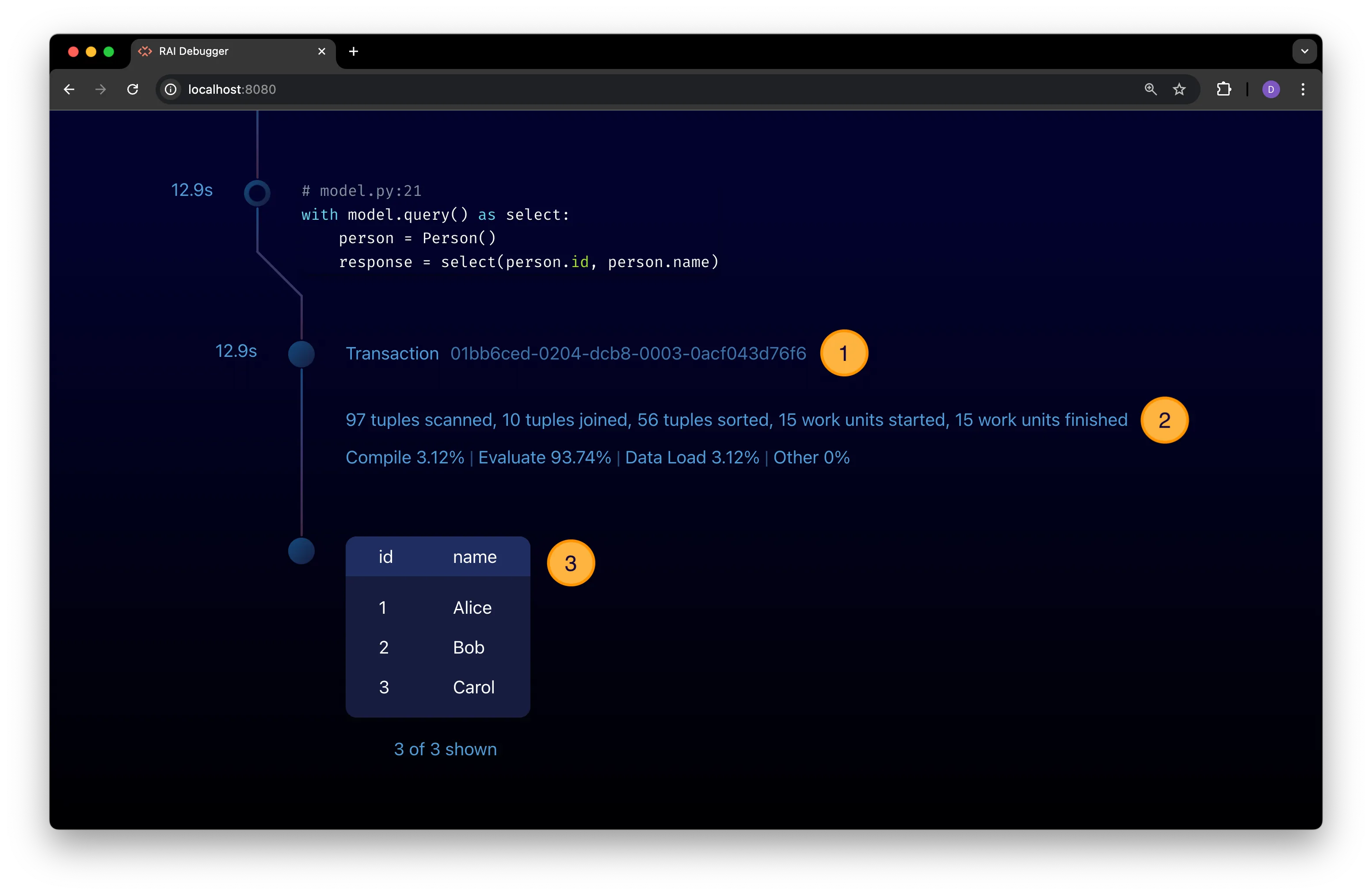
The expanded view shows:
-
A transaction node with the transaction’s unique ID and its total elapsed execution time.
-
Some profiling statistics for the query execution including tuple and execution stats. See Understand Profile Stats for more details on these stats.
-
A table with the query results.
Transaction Nodes
Section titled “Transaction Nodes”Transaction nodes are shown on the execution timeline as a single dot labeled with the word Transaction and a unique ID:
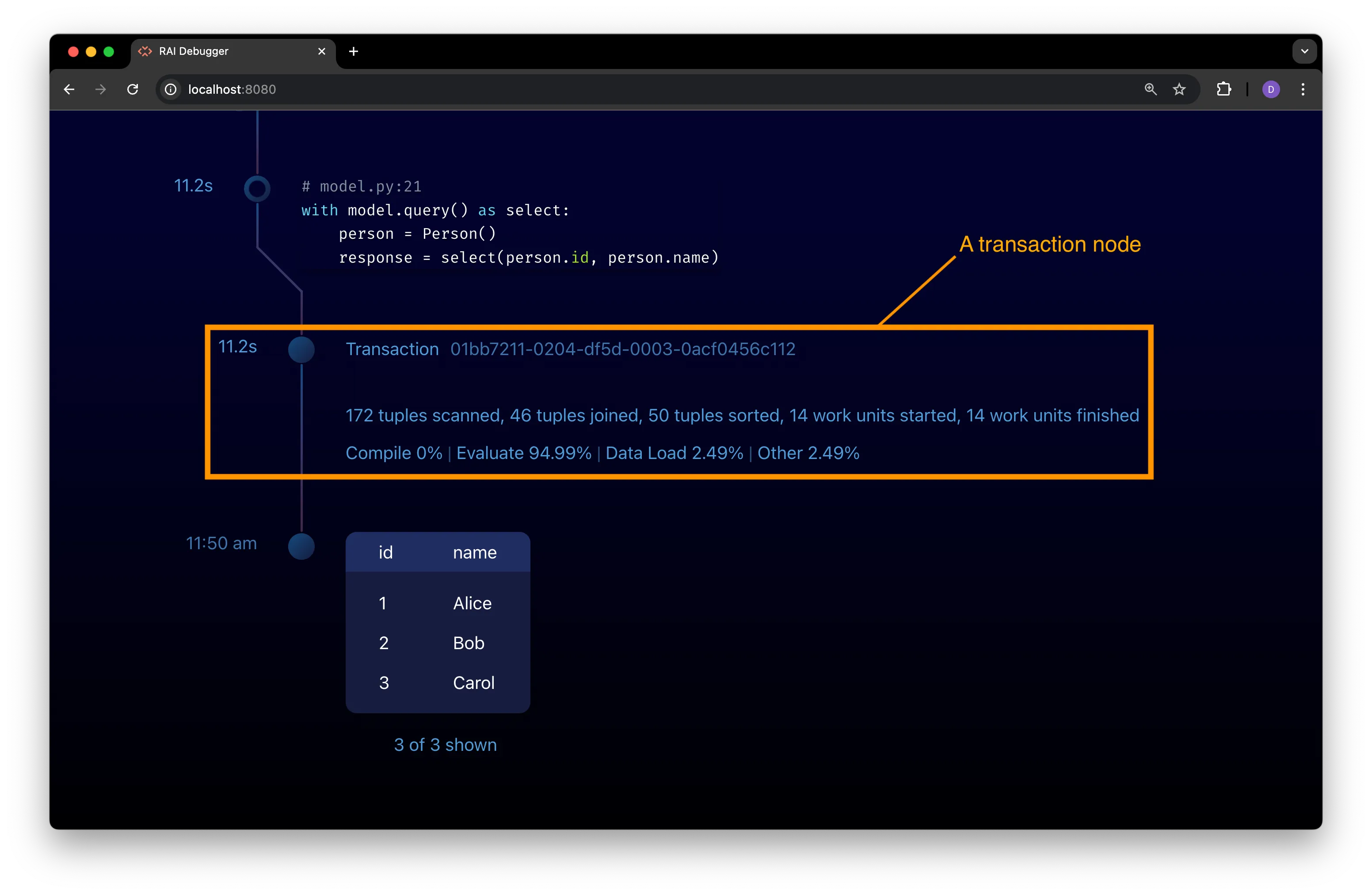
Both rules nodes and query nodes may have a transaction node in their expanded view.
Below the transaction node is some basic profiling statistics for the transaction. See Understand Profile Stats for details on interpreting these statistics.
The debug.jsonl File
Section titled “The debug.jsonl File”When you run a program with the debugger enabled, a debug.jsonl file is created in the directory that you ran the program from.
This file contains the raw debug logs for the most recent program execution, since each time you run the program the file is overwritten.
You can view the contents of the debug.jsonl file using the debugger interface by dragging and dropping the file into your browser window with the debugger open.
Note that the timeline in the debugger interface is cleared and the contents of the debug.jsonl file are rendered as a new timeline.
Multiple Connections
Section titled “Multiple Connections”The debug server can accept a connection from any program running on a machine with access to the server’s network URL. You can view the URL in the settings panel.
Multiple programs can be viewed in the same timeline. Each program is represented by its own program node.
Understand Profile Stats
Section titled “Understand Profile Stats”The profile statistics displayed by transaction nodes expose information about the execution of a transaction. To fully understand the profile stats, it helps to understand the execution model for a RAI program.
The RAI Program Lifecycle
Section titled “The RAI Program Lifecycle”When you query a model built with the RAI Python API, the query is not evaluated on your local machine. The model sends transactions to the RAI engine specified in the model’s configuration. The engine evaluates the query and results are returned to the local Python runtime.
Query Execution Loop
Section titled “Query Execution Loop”Programs execute in a loop that repeats the following three steps:
-
Collect rules.
Each rule context encountered by the interpreter generates logic in an intermediate representation (IR) that is tracked by the program’s
Modelobject. The model collects rules until the interpreter encounters a query context. -
Install compiled rules.
When the first query context is interpreted, all of the rules collected in Step 1 are compiled together. A transaction is sent to the model’s RAI engine to install the compiled IR so that this and all subsequent queries can use the rules without recompiling them.
-
Evaluate a query.
The logic contained in a query context is compiled into IR and sent to the engine for evaluation in another transaction. Your local Python runtime blocks until results are returned.
Once a transaction returns query results, the local runtime continues to interpret your program by returning to Step 1 to process more rules until the next query context is encountered.
Execution Phases
Section titled “Execution Phases”Transaction execution is divided into multiple execution phases:
- During the compilation phase, a query plan is generated for the transaction.
- The query plan is evaluated during the evaluation phase.
- Any data that must be loaded for the transaction is done during a data load phase.
The percentage of total time spent in each of these phases is shown in the compact stats view displayed below the transaction node.
Read Compact Profile Stats
Section titled “Read Compact Profile Stats”A transaction node’s default compact view displays statistics that give an overview of the transaction’s execution:
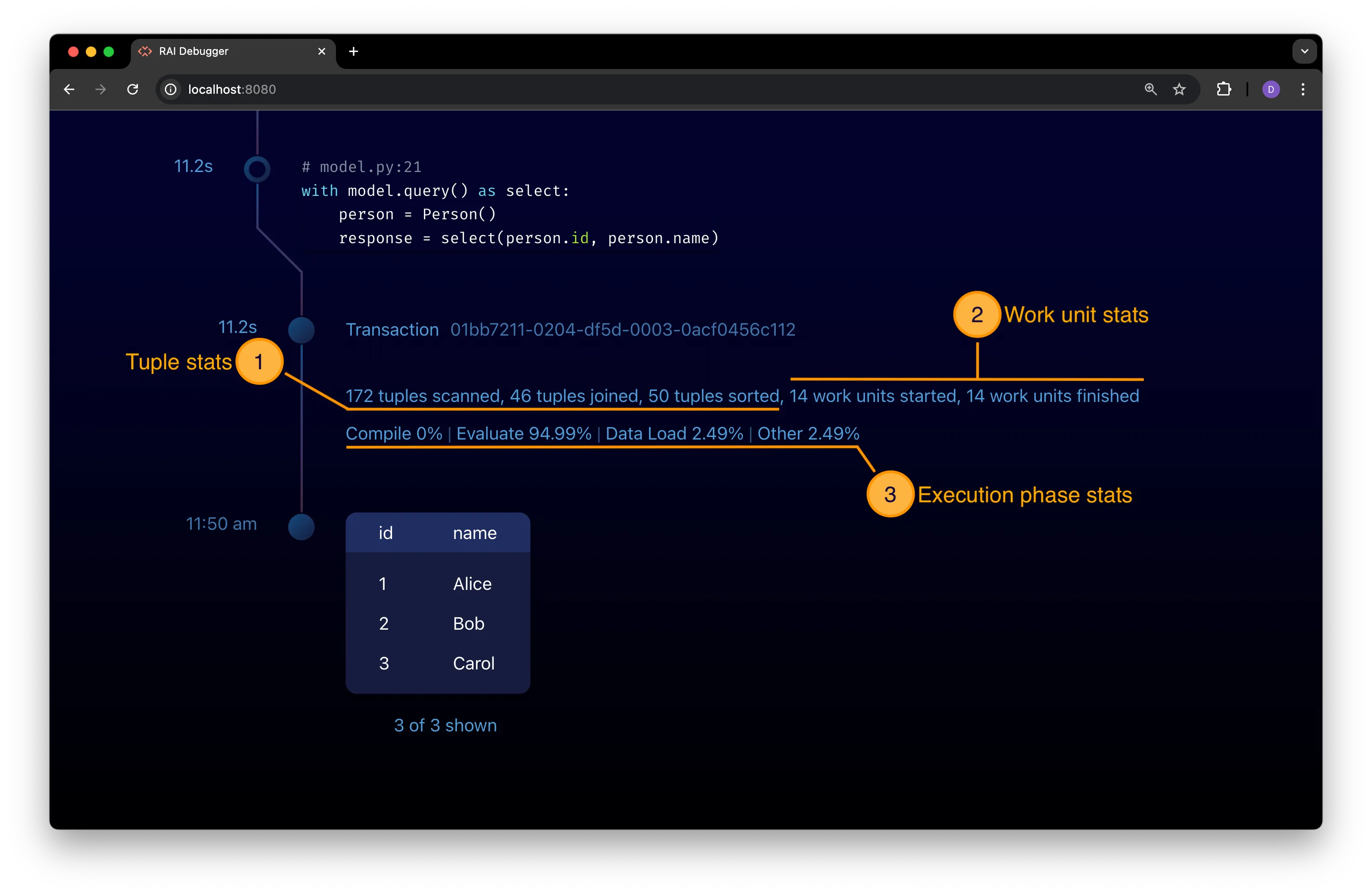
Knowing how to interpret these stats can help you identify potential performance issues in your program.
Use the tabs below to learn more about the different types of stats:
Interpret Tuple Stats
Section titled “Interpret Tuple Stats”A tuple is a row of relational data generated by the RAI engine during the execution of a transaction. The compact profile view (see preceding figure) shows you the:
- Total number of tuples scanned—or, generated—during the transaction.
- Number of join operations performed.
- Number of tuples that had to be sorted.
The number of tuples generated by a program is a function of both the number of rows in the source data and the complexity of the rules evaluated by the program. This number can be very large, even if the source data is small.
Look out for transactions with many joins or sorts relative to the total number of tuples. This indicates that the transaction is doing a lot of work and warrants further investigation.
Interpret Work Unit Stats
Section titled “Interpret Work Unit Stats”Work done by the engine to evaluate the transaction is divided into work units that are executed in parallel. Note that work units are not the same as the CPU cores available to the engine.
The compact transaction view (see preceding figure) shows you the:
- Number of work units started by the transaction.
- Number of those work units that have completed their work.
The key thing to look out for here is work units that never terminate. This may indicate that the program’s rules are recursive and stuck in an infinite loop. If necessary, you can cancel a long-running transaction. You’ll need the transaction ID, which is shown next to the transaction node’s timeline icon.
Interpret Execution Phase Stats
Section titled “Interpret Execution Phase Stats”Statistics about the execution phase of a transaction are shown in the compact profile view as a percentage of the total time spent in each execution phase.
Four phases are shown:
- Compilation phase: The time spent compiling the transaction.
- Evaluation phase: The time spent evaluating the transaction.
- Data load phase: The time spent loading data for the transaction.
- Other phase: The time spent on other tasks.
Typically, the evaluation phase dominates the total execution time.
View Rule Compilation Details
Section titled “View Rule Compilation Details”To view compilation details for individual rules, expand the installation node that appears after the rules node in the timeline once the transaction is complete:

Each individual rule is shown with its compile size to the left of the rule’s timeline icon, and the rule’s code to the right of the icon.
The rules are sorted by compile size, with the largest compiled rules at the top of the list to help identify rules that may be too large or complex.
View Query Execution Details
Section titled “View Query Execution Details”To view query execution details broken down by individual rule, expand the query’s transaction node in the timeline:
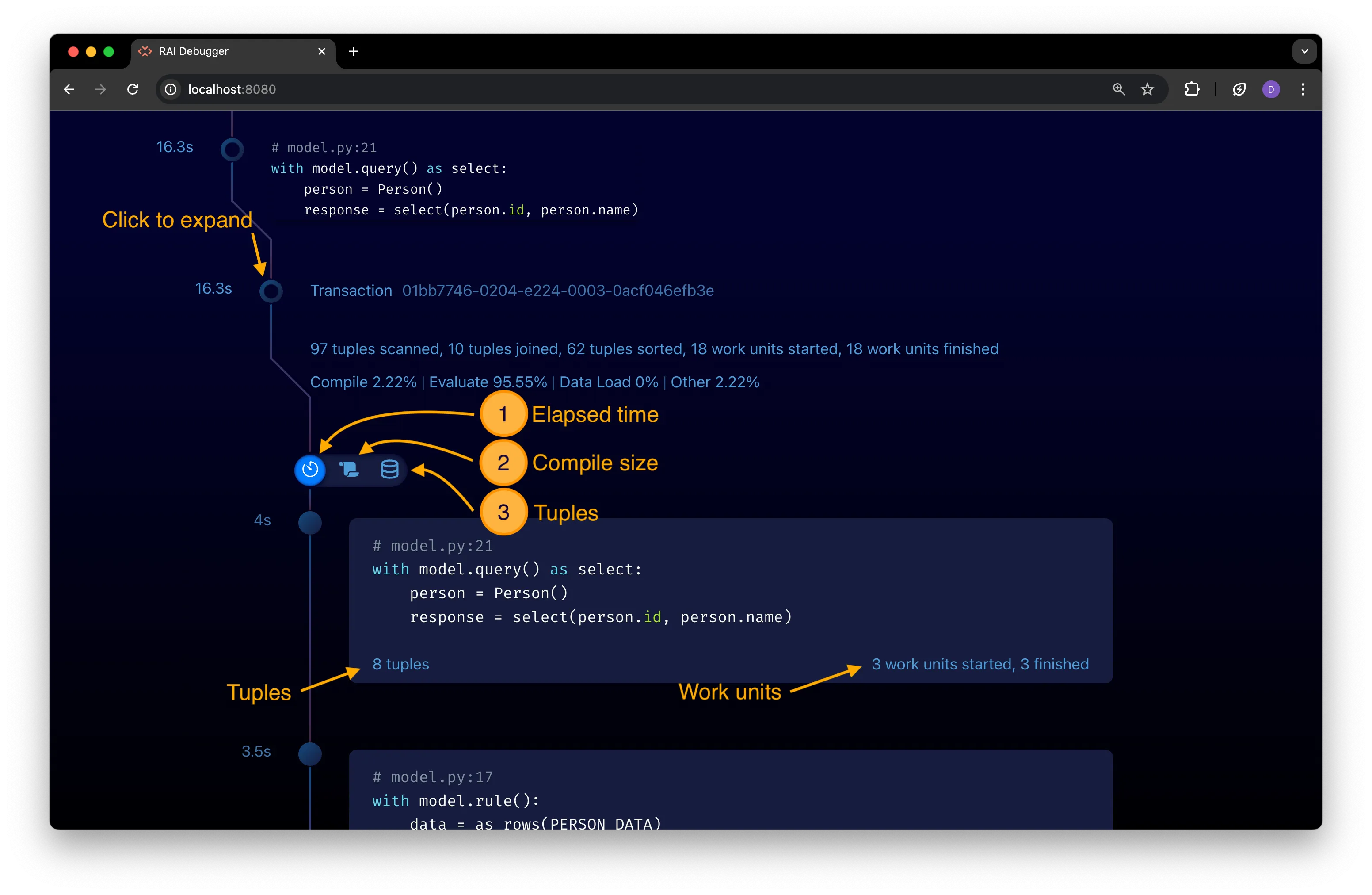
Each individual rule is shown with the:
- Elapsed time to the left of rule’s timeline icon.
- Rule’s code to the right of the icon.
- Tuples processed by the rule during the query’s execution in the bottom left corner.
- Work units started and completed during the rule’s evaluation in the bottom right corner.
By default, rules are sorted by their elapsed execution time, with the longest running rules at the top of the list. Change the sort order by clicking on one of the icons in the menu (see preceding figure) just below the transaction node:
-
Elapsed time: The total elapsed time that the rule took to execute. Sort by this to identify the rules that took the longest to evaluate.
-
Compile size: The size in bytes of the compiled IR for rule. Sort by this to identify the largest compiled rules. See View Rule Compilation Details for more details on interpreting this stat.
-
Tuples: The number of tuples processed by the rule during the query’s execution. Use this view to identify rules that require computing large amounts of data.
Interpret Cross Product Warnings
Section titled “Interpret Cross Product Warnings”Cross products are identified by the debugger. Expand a query’s transaction node to view query execution details. Look for a rule with a warning icon in the bottom right corner of the rule’s code block, like in the following figure:

A cross product, also known as a Cartesian product, occurs when two or more variables in a rule or query are not related to each other in any way. This forces the RAI engine to generate all possible combinations of values for the variables. Large cross products can have a significant impact on performance.
The rule in the preceding figure has a cross product because every pair of employee and company entities must be generated in order to evaluate the rule.
In this case, it’s a logical error, and the rule should be edited to remove the cross product:
# To fix the cross product, add a condition to relate the employee and company:with model.rule(): employee = Employee() company = Company() employee.company_id == company.id # <-- Add condition to relate employee and company employee.start_date <= company.date_founded + dates.months(6) employee.set(FoundingEmployee)
# Or, alternatively, reference the employee's company property directly:with model.rule(): employee = Employee() employee.start_date <= employee.company.date_founded + dates.months(6) employee.set(FoundingEmployee)Sometimes, cross products arise from rules that operate on independent sets of variables.
The following rule sets properties for Employee and Company entities, but the employee and company variables are not related to each other way:
from relationalai.std import dates
# BAD:# An unnecessary cross product.with model.rule(): employee = Employee() company = Company() # <-- No condition to relate employee to company employee.set(start_year = dates.year(employee.start_date)) company.set(founded_year = dates.year(company.date_founded))
# GOOD:# Independent actions are split into separate rules.with model.rule(): employee = Employee() employee.set(start_year = dates.year(employee.start_date))
with model.rule(): company = Company() company.set(founded_year = dates.year(company.date_founded))The cross product in the first rule is unnecessary because the actions on the employee and company variables are independent of each other.
Logically, the rule is correct, but all possible pairs of employee and company entities must be generated to evaluate the rule.
When split into two separate rules, the same effect is achieved without a cross product.